EX-99.1
Published on February 15, 2023
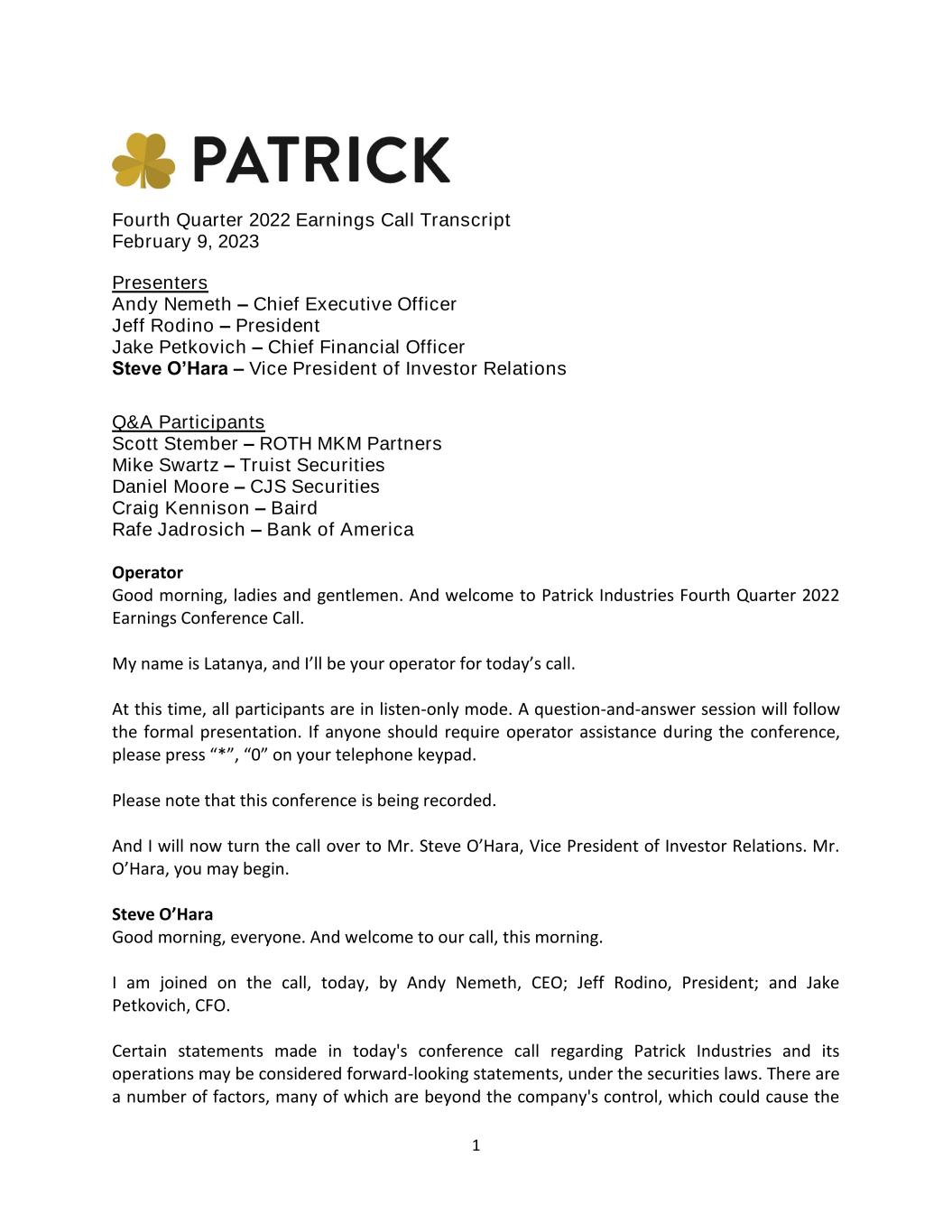
1 Fourth Quarter 2022 Earnings Call Transcript February 9, 2023 Presenters Andy Nemeth – Chief Executive Officer Jeff Rodino – President Jake Petkovich – Chief Financial Officer Steve O’Hara – Vice President of Investor Relations Q&A Participants Scott Stember – ROTH MKM Partners Mike Swartz – Truist Securities Daniel Moore – CJS Securities Craig Kennison – Baird Rafe Jadrosich – Bank of America Operator Good morning, ladies and gentlemen. And welcome to Patrick Industries Fourth Quarter 2022 Earnings Conference Call. My name is Latanya, and I’ll be your operator for today’s call. At this time, all participants are in listen-only mode. A question-and-answer session will follow the formal presentation. If anyone should require operator assistance during the conference, please press “*”, “0” on your telephone keypad. Please note that this conference is being recorded. And I will now turn the call over to Mr. Steve O’Hara, Vice President of Investor Relations. Mr. O’Hara, you may begin. Steve O’Hara Good morning, everyone. And welcome to our call, this morning. I am joined on the call, today, by Andy Nemeth, CEO; Jeff Rodino, President; and Jake Petkovich, CFO. Certain statements made in today's conference call regarding Patrick Industries and its operations may be considered forward-looking statements, under the securities laws. There are a number of factors, many of which are beyond the company's control, which could cause the
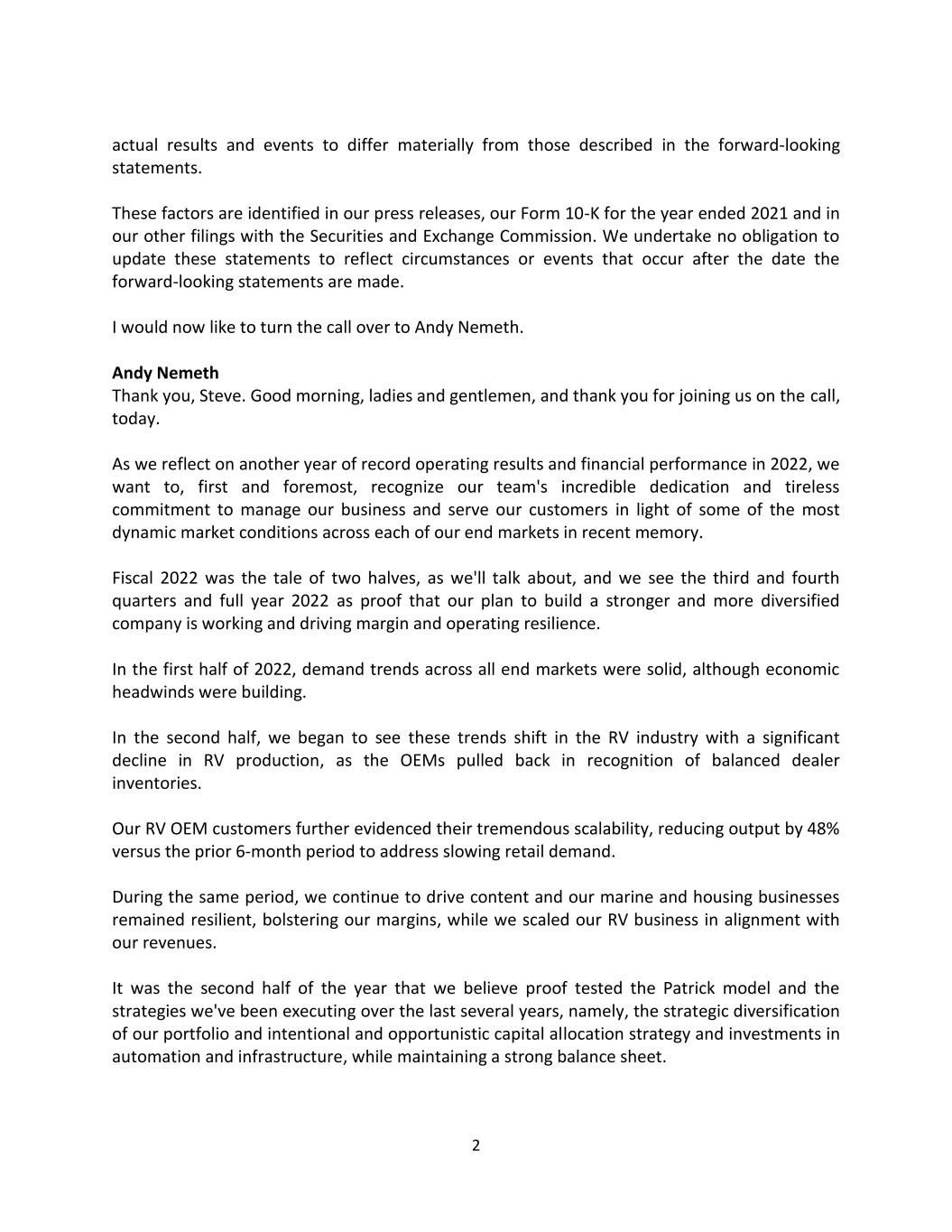
2 actual results and events to differ materially from those described in the forward-looking statements. These factors are identified in our press releases, our Form 10-K for the year ended 2021 and in our other filings with the Securities and Exchange Commission. We undertake no obligation to update these statements to reflect circumstances or events that occur after the date the forward-looking statements are made. I would now like to turn the call over to Andy Nemeth. Andy Nemeth Thank you, Steve. Good morning, ladies and gentlemen, and thank you for joining us on the call, today. As we reflect on another year of record operating results and financial performance in 2022, we want to, first and foremost, recognize our team's incredible dedication and tireless commitment to manage our business and serve our customers in light of some of the most dynamic market conditions across each of our end markets in recent memory. Fiscal 2022 was the tale of two halves, as we'll talk about, and we see the third and fourth quarters and full year 2022 as proof that our plan to build a stronger and more diversified company is working and driving margin and operating resilience. In the first half of 2022, demand trends across all end markets were solid, although economic headwinds were building. In the second half, we began to see these trends shift in the RV industry with a significant decline in RV production, as the OEMs pulled back in recognition of balanced dealer inventories. Our RV OEM customers further evidenced their tremendous scalability, reducing output by 48% versus the prior 6-month period to address slowing retail demand. During the same period, we continue to drive content and our marine and housing businesses remained resilient, bolstering our margins, while we scaled our RV business in alignment with our revenues. It was the second half of the year that we believe proof tested the Patrick model and the strategies we've been executing over the last several years, namely, the strategic diversification of our portfolio and intentional and opportunistic capital allocation strategy and investments in automation and infrastructure, while maintaining a strong balance sheet.
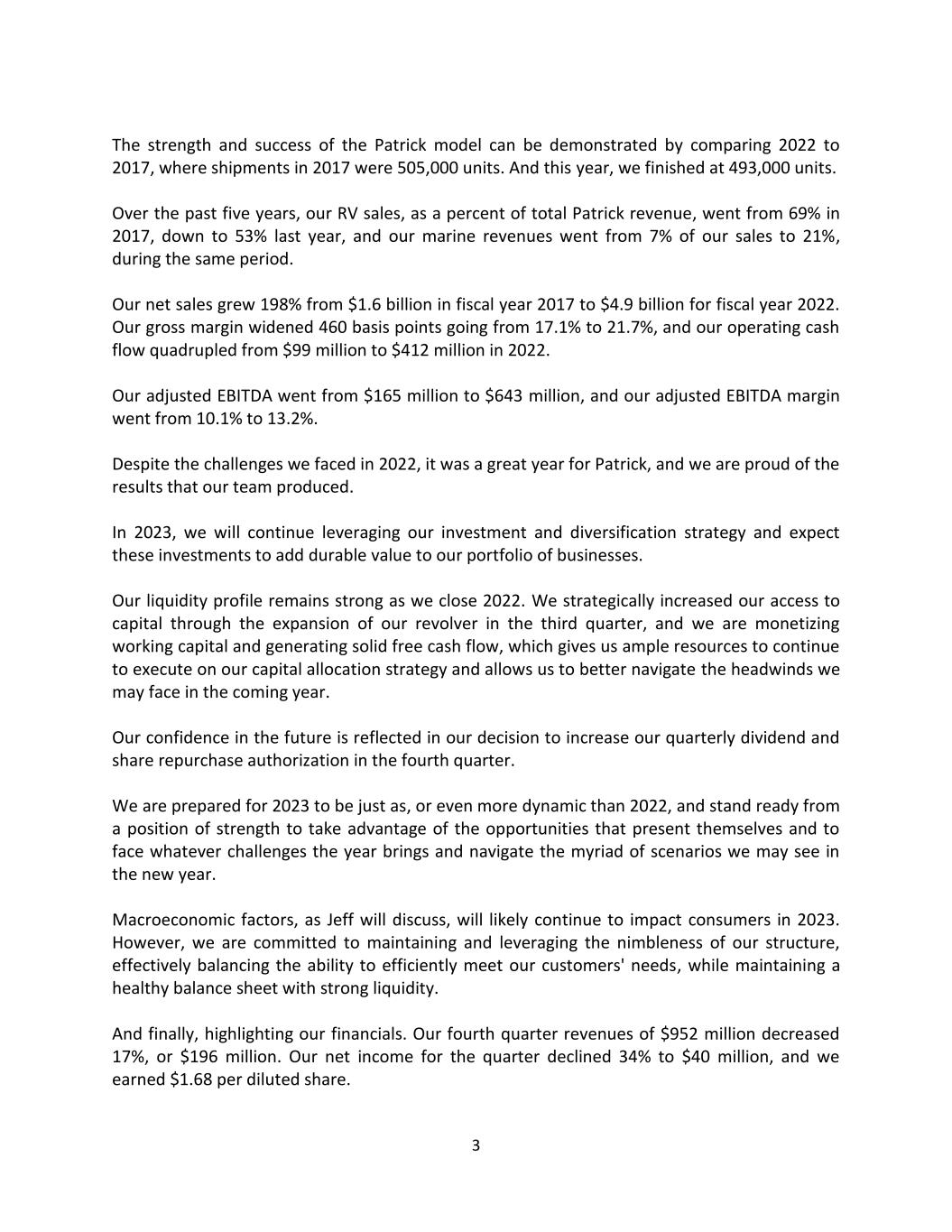
3 The strength and success of the Patrick model can be demonstrated by comparing 2022 to 2017, where shipments in 2017 were 505,000 units. And this year, we finished at 493,000 units. Over the past five years, our RV sales, as a percent of total Patrick revenue, went from 69% in 2017, down to 53% last year, and our marine revenues went from 7% of our sales to 21%, during the same period. Our net sales grew 198% from $1.6 billion in fiscal year 2017 to $4.9 billion for fiscal year 2022. Our gross margin widened 460 basis points going from 17.1% to 21.7%, and our operating cash flow quadrupled from $99 million to $412 million in 2022. Our adjusted EBITDA went from $165 million to $643 million, and our adjusted EBITDA margin went from 10.1% to 13.2%. Despite the challenges we faced in 2022, it was a great year for Patrick, and we are proud of the results that our team produced. In 2023, we will continue leveraging our investment and diversification strategy and expect these investments to add durable value to our portfolio of businesses. Our liquidity profile remains strong as we close 2022. We strategically increased our access to capital through the expansion of our revolver in the third quarter, and we are monetizing working capital and generating solid free cash flow, which gives us ample resources to continue to execute on our capital allocation strategy and allows us to better navigate the headwinds we may face in the coming year. Our confidence in the future is reflected in our decision to increase our quarterly dividend and share repurchase authorization in the fourth quarter. We are prepared for 2023 to be just as, or even more dynamic than 2022, and stand ready from a position of strength to take advantage of the opportunities that present themselves and to face whatever challenges the year brings and navigate the myriad of scenarios we may see in the new year. Macroeconomic factors, as Jeff will discuss, will likely continue to impact consumers in 2023. However, we are committed to maintaining and leveraging the nimbleness of our structure, effectively balancing the ability to efficiently meet our customers' needs, while maintaining a healthy balance sheet with strong liquidity. And finally, highlighting our financials. Our fourth quarter revenues of $952 million decreased 17%, or $196 million. Our net income for the quarter declined 34% to $40 million, and we earned $1.68 per diluted share.
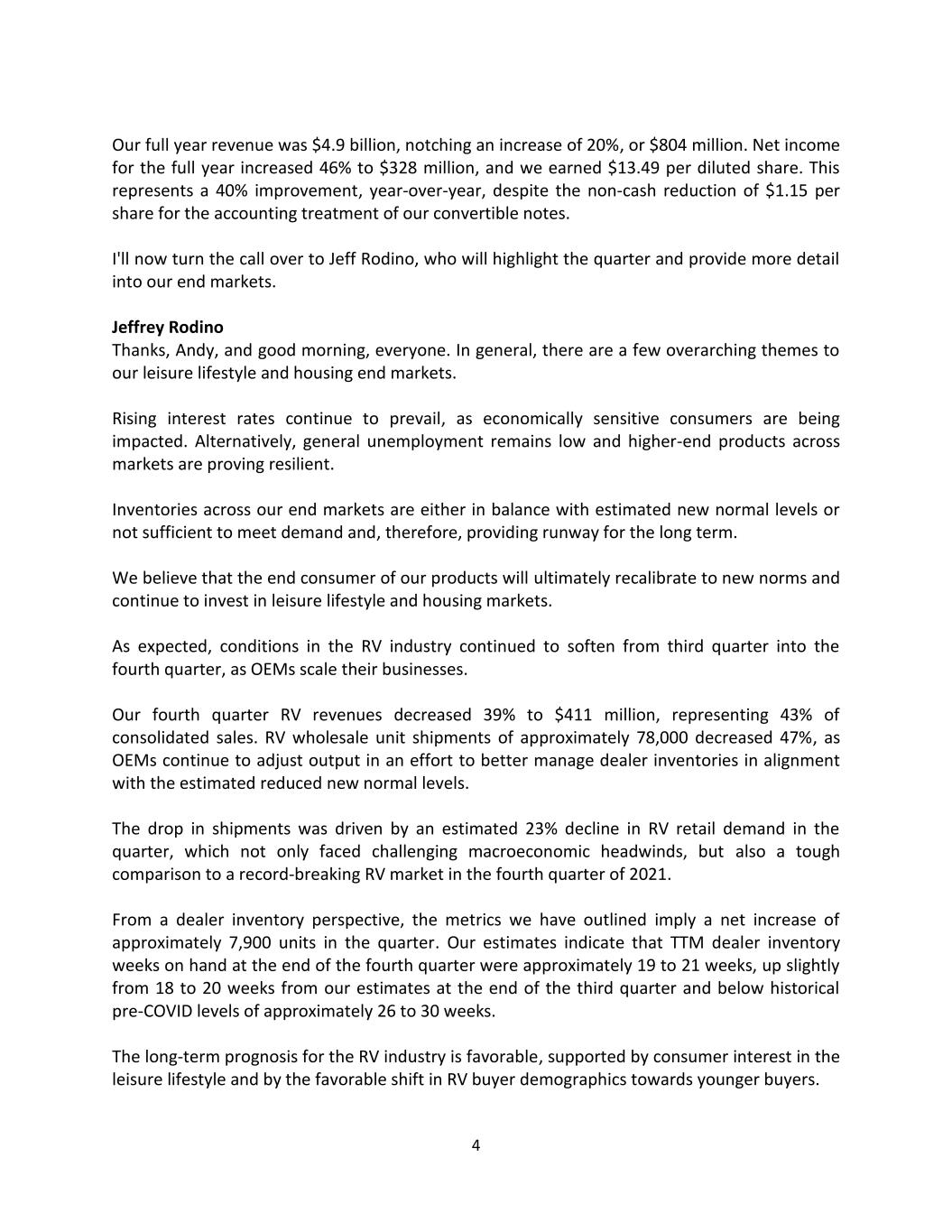
4 Our full year revenue was $4.9 billion, notching an increase of 20%, or $804 million. Net income for the full year increased 46% to $328 million, and we earned $13.49 per diluted share. This represents a 40% improvement, year-over-year, despite the non-cash reduction of $1.15 per share for the accounting treatment of our convertible notes. I'll now turn the call over to Jeff Rodino, who will highlight the quarter and provide more detail into our end markets. Jeffrey Rodino Thanks, Andy, and good morning, everyone. In general, there are a few overarching themes to our leisure lifestyle and housing end markets. Rising interest rates continue to prevail, as economically sensitive consumers are being impacted. Alternatively, general unemployment remains low and higher-end products across markets are proving resilient. Inventories across our end markets are either in balance with estimated new normal levels or not sufficient to meet demand and, therefore, providing runway for the long term. We believe that the end consumer of our products will ultimately recalibrate to new norms and continue to invest in leisure lifestyle and housing markets. As expected, conditions in the RV industry continued to soften from third quarter into the fourth quarter, as OEMs scale their businesses. Our fourth quarter RV revenues decreased 39% to $411 million, representing 43% of consolidated sales. RV wholesale unit shipments of approximately 78,000 decreased 47%, as OEMs continue to adjust output in an effort to better manage dealer inventories in alignment with the estimated reduced new normal levels. The drop in shipments was driven by an estimated 23% decline in RV retail demand in the quarter, which not only faced challenging macroeconomic headwinds, but also a tough comparison to a record-breaking RV market in the fourth quarter of 2021. From a dealer inventory perspective, the metrics we have outlined imply a net increase of approximately 7,900 units in the quarter. Our estimates indicate that TTM dealer inventory weeks on hand at the end of the fourth quarter were approximately 19 to 21 weeks, up slightly from 18 to 20 weeks from our estimates at the end of the third quarter and below historical pre-COVID levels of approximately 26 to 30 weeks. The long-term prognosis for the RV industry is favorable, supported by consumer interest in the leisure lifestyle and by the favorable shift in RV buyer demographics towards younger buyers.
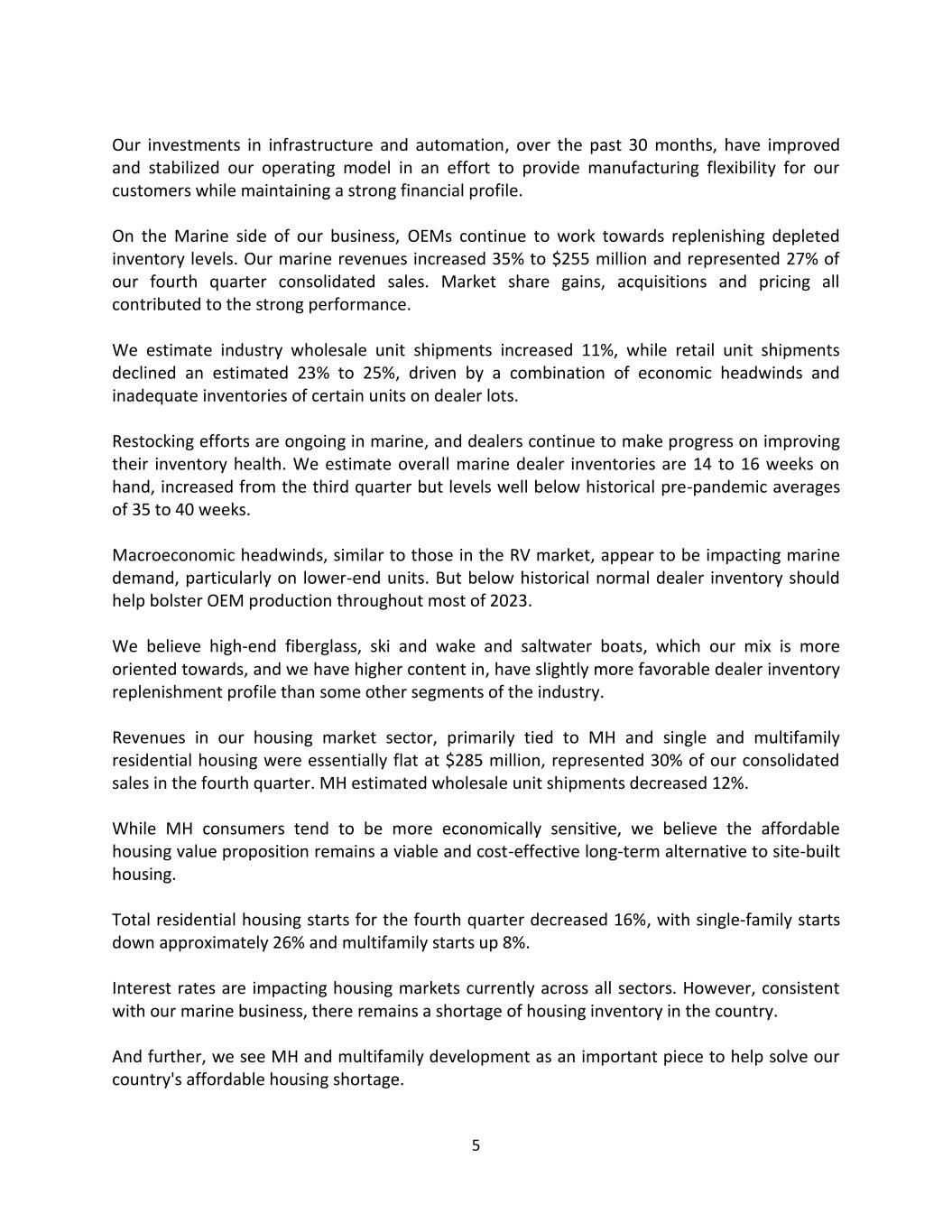
5 Our investments in infrastructure and automation, over the past 30 months, have improved and stabilized our operating model in an effort to provide manufacturing flexibility for our customers while maintaining a strong financial profile. On the Marine side of our business, OEMs continue to work towards replenishing depleted inventory levels. Our marine revenues increased 35% to $255 million and represented 27% of our fourth quarter consolidated sales. Market share gains, acquisitions and pricing all contributed to the strong performance. We estimate industry wholesale unit shipments increased 11%, while retail unit shipments declined an estimated 23% to 25%, driven by a combination of economic headwinds and inadequate inventories of certain units on dealer lots. Restocking efforts are ongoing in marine, and dealers continue to make progress on improving their inventory health. We estimate overall marine dealer inventories are 14 to 16 weeks on hand, increased from the third quarter but levels well below historical pre-pandemic averages of 35 to 40 weeks. Macroeconomic headwinds, similar to those in the RV market, appear to be impacting marine demand, particularly on lower-end units. But below historical normal dealer inventory should help bolster OEM production throughout most of 2023. We believe high-end fiberglass, ski and wake and saltwater boats, which our mix is more oriented towards, and we have higher content in, have slightly more favorable dealer inventory replenishment profile than some other segments of the industry. Revenues in our housing market sector, primarily tied to MH and single and multifamily residential housing were essentially flat at $285 million, represented 30% of our consolidated sales in the fourth quarter. MH estimated wholesale unit shipments decreased 12%. While MH consumers tend to be more economically sensitive, we believe the affordable housing value proposition remains a viable and cost-effective long-term alternative to site-built housing. Total residential housing starts for the fourth quarter decreased 16%, with single-family starts down approximately 26% and multifamily starts up 8%. Interest rates are impacting housing markets currently across all sectors. However, consistent with our marine business, there remains a shortage of housing inventory in the country. And further, we see MH and multifamily development as an important piece to help solve our country's affordable housing shortage.
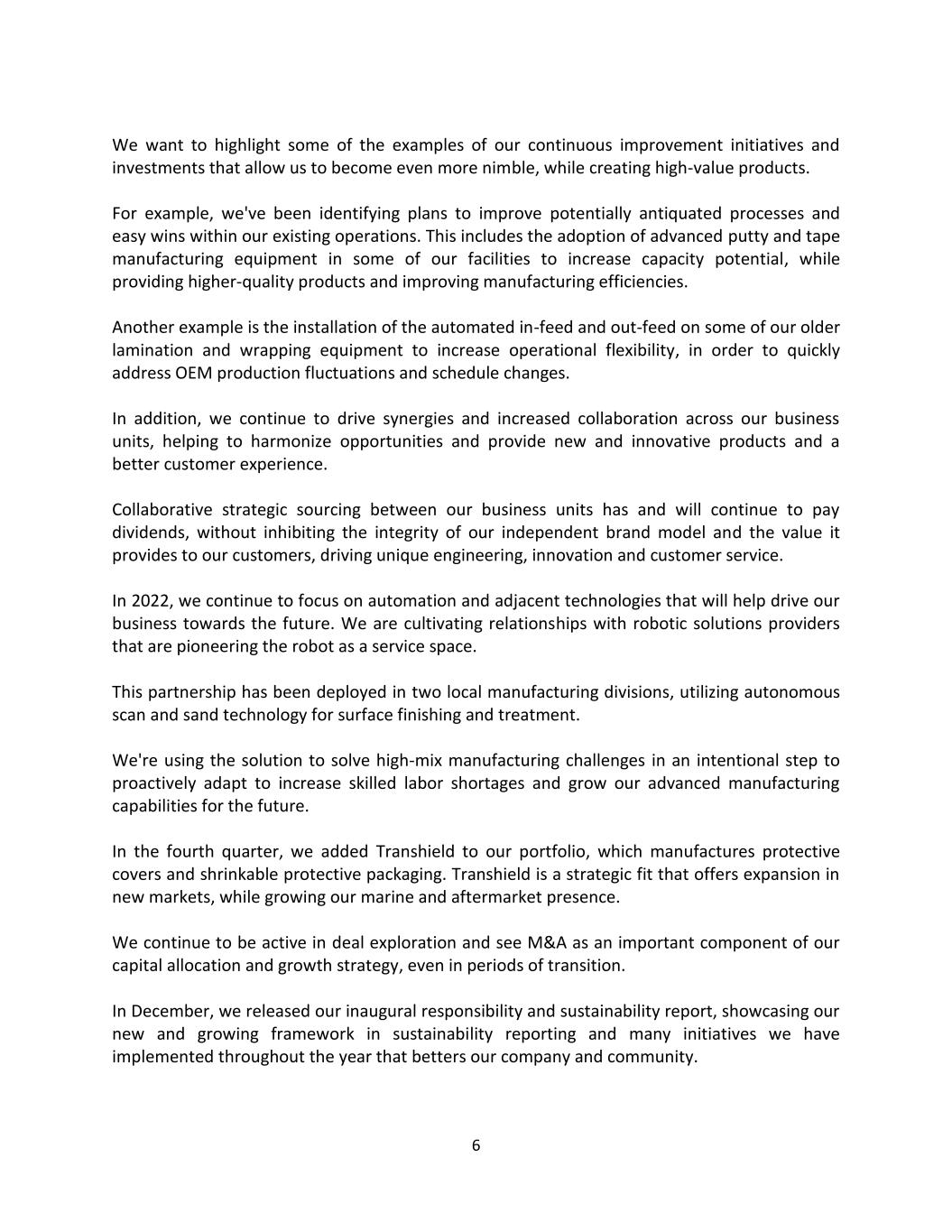
6 We want to highlight some of the examples of our continuous improvement initiatives and investments that allow us to become even more nimble, while creating high-value products. For example, we've been identifying plans to improve potentially antiquated processes and easy wins within our existing operations. This includes the adoption of advanced putty and tape manufacturing equipment in some of our facilities to increase capacity potential, while providing higher-quality products and improving manufacturing efficiencies. Another example is the installation of the automated in-feed and out-feed on some of our older lamination and wrapping equipment to increase operational flexibility, in order to quickly address OEM production fluctuations and schedule changes. In addition, we continue to drive synergies and increased collaboration across our business units, helping to harmonize opportunities and provide new and innovative products and a better customer experience. Collaborative strategic sourcing between our business units has and will continue to pay dividends, without inhibiting the integrity of our independent brand model and the value it provides to our customers, driving unique engineering, innovation and customer service. In 2022, we continue to focus on automation and adjacent technologies that will help drive our business towards the future. We are cultivating relationships with robotic solutions providers that are pioneering the robot as a service space. This partnership has been deployed in two local manufacturing divisions, utilizing autonomous scan and sand technology for surface finishing and treatment. We're using the solution to solve high-mix manufacturing challenges in an intentional step to proactively adapt to increase skilled labor shortages and grow our advanced manufacturing capabilities for the future. In the fourth quarter, we added Transhield to our portfolio, which manufactures protective covers and shrinkable protective packaging. Transhield is a strategic fit that offers expansion in new markets, while growing our marine and aftermarket presence. We continue to be active in deal exploration and see M&A as an important component of our capital allocation and growth strategy, even in periods of transition. In December, we released our inaugural responsibility and sustainability report, showcasing our new and growing framework in sustainability reporting and many initiatives we have implemented throughout the year that betters our company and community.
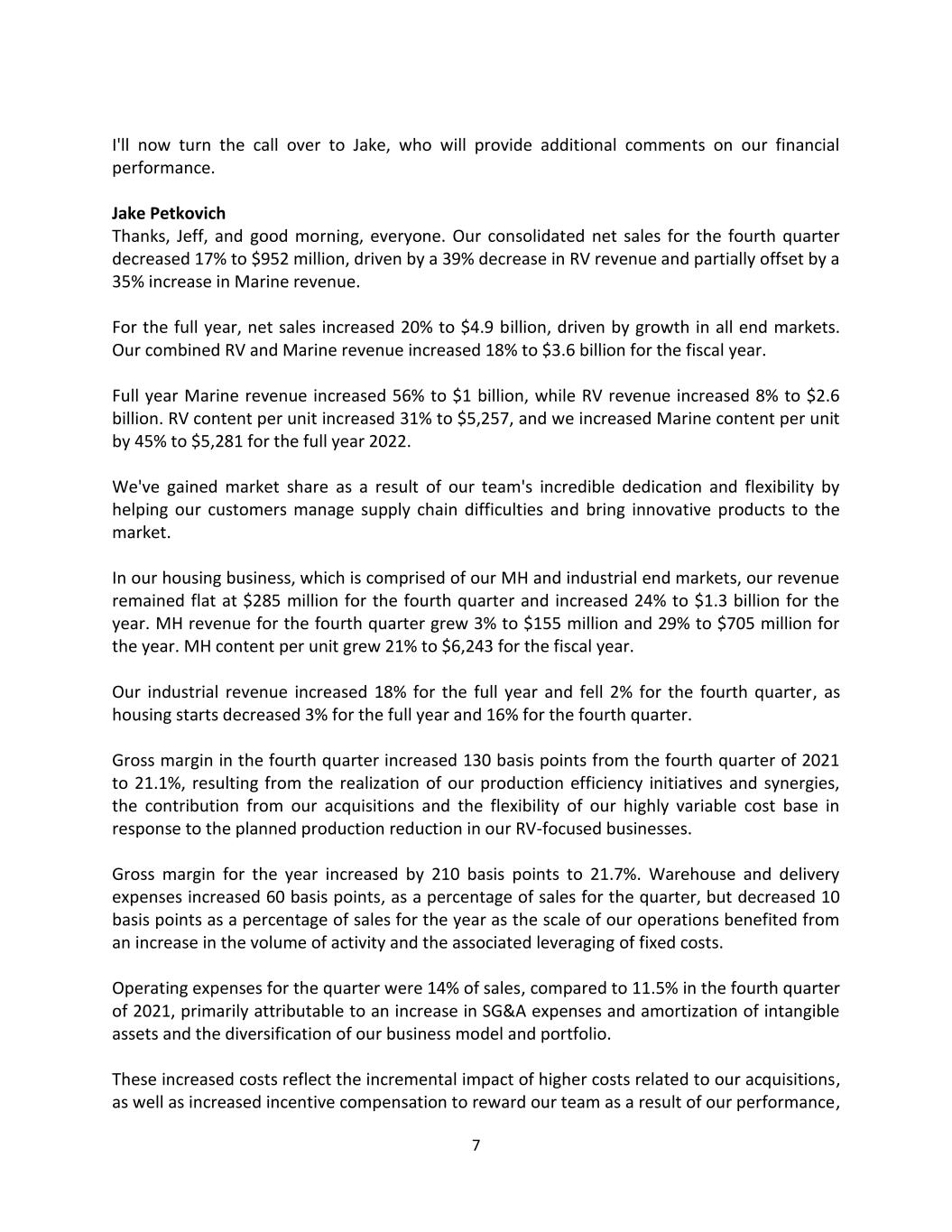
7 I'll now turn the call over to Jake, who will provide additional comments on our financial performance. Jake Petkovich Thanks, Jeff, and good morning, everyone. Our consolidated net sales for the fourth quarter decreased 17% to $952 million, driven by a 39% decrease in RV revenue and partially offset by a 35% increase in Marine revenue. For the full year, net sales increased 20% to $4.9 billion, driven by growth in all end markets. Our combined RV and Marine revenue increased 18% to $3.6 billion for the fiscal year. Full year Marine revenue increased 56% to $1 billion, while RV revenue increased 8% to $2.6 billion. RV content per unit increased 31% to $5,257, and we increased Marine content per unit by 45% to $5,281 for the full year 2022. We've gained market share as a result of our team's incredible dedication and flexibility by helping our customers manage supply chain difficulties and bring innovative products to the market. In our housing business, which is comprised of our MH and industrial end markets, our revenue remained flat at $285 million for the fourth quarter and increased 24% to $1.3 billion for the year. MH revenue for the fourth quarter grew 3% to $155 million and 29% to $705 million for the year. MH content per unit grew 21% to $6,243 for the fiscal year. Our industrial revenue increased 18% for the full year and fell 2% for the fourth quarter, as housing starts decreased 3% for the full year and 16% for the fourth quarter. Gross margin in the fourth quarter increased 130 basis points from the fourth quarter of 2021 to 21.1%, resulting from the realization of our production efficiency initiatives and synergies, the contribution from our acquisitions and the flexibility of our highly variable cost base in response to the planned production reduction in our RV-focused businesses. Gross margin for the year increased by 210 basis points to 21.7%. Warehouse and delivery expenses increased 60 basis points, as a percentage of sales for the quarter, but decreased 10 basis points as a percentage of sales for the year as the scale of our operations benefited from an increase in the volume of activity and the associated leveraging of fixed costs. Operating expenses for the quarter were 14% of sales, compared to 11.5% in the fourth quarter of 2021, primarily attributable to an increase in SG&A expenses and amortization of intangible assets and the diversification of our business model and portfolio. These increased costs reflect the incremental impact of higher costs related to our acquisitions, as well as increased incentive compensation to reward our team as a result of our performance,
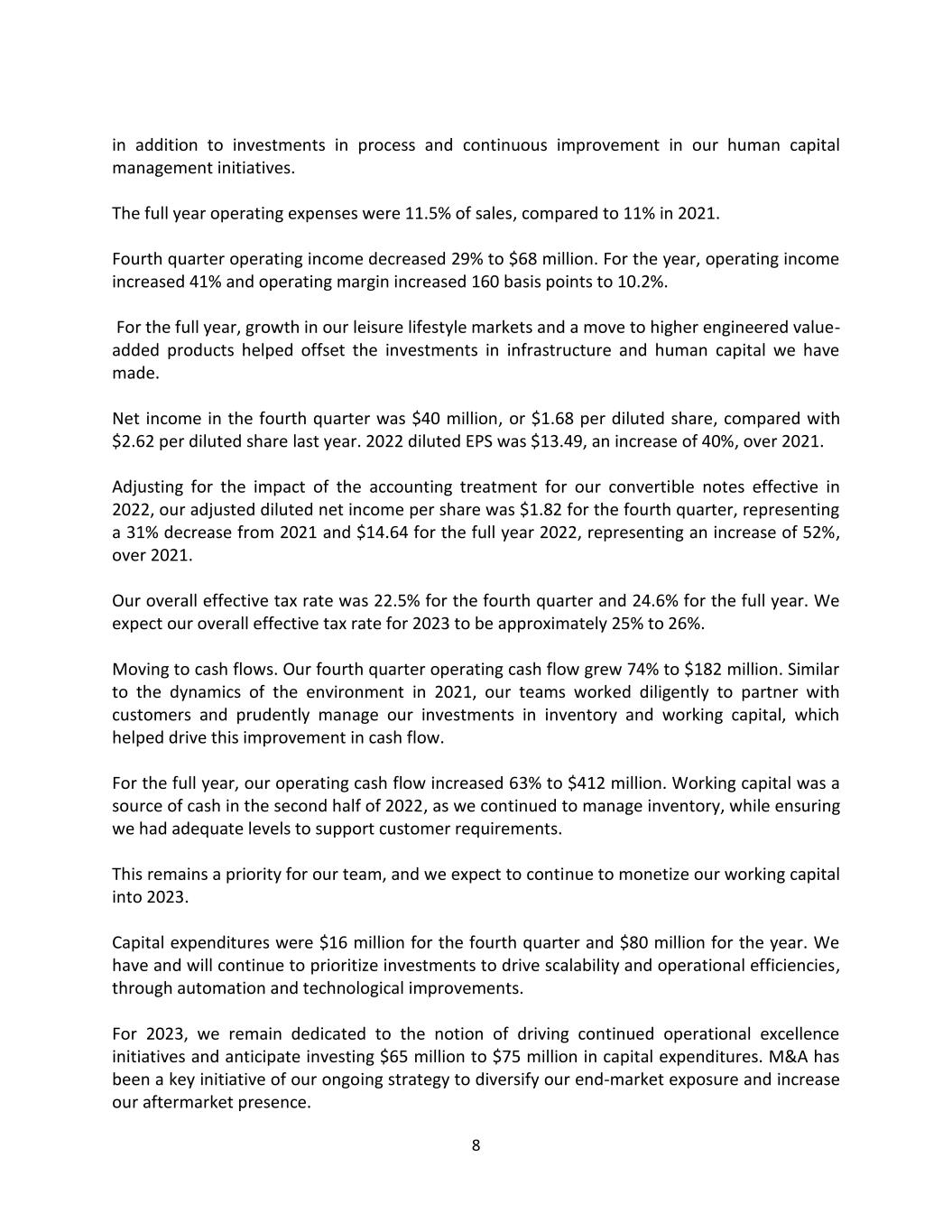
8 in addition to investments in process and continuous improvement in our human capital management initiatives. The full year operating expenses were 11.5% of sales, compared to 11% in 2021. Fourth quarter operating income decreased 29% to $68 million. For the year, operating income increased 41% and operating margin increased 160 basis points to 10.2%. For the full year, growth in our leisure lifestyle markets and a move to higher engineered value- added products helped offset the investments in infrastructure and human capital we have made. Net income in the fourth quarter was $40 million, or $1.68 per diluted share, compared with $2.62 per diluted share last year. 2022 diluted EPS was $13.49, an increase of 40%, over 2021. Adjusting for the impact of the accounting treatment for our convertible notes effective in 2022, our adjusted diluted net income per share was $1.82 for the fourth quarter, representing a 31% decrease from 2021 and $14.64 for the full year 2022, representing an increase of 52%, over 2021. Our overall effective tax rate was 22.5% for the fourth quarter and 24.6% for the full year. We expect our overall effective tax rate for 2023 to be approximately 25% to 26%. Moving to cash flows. Our fourth quarter operating cash flow grew 74% to $182 million. Similar to the dynamics of the environment in 2021, our teams worked diligently to partner with customers and prudently manage our investments in inventory and working capital, which helped drive this improvement in cash flow. For the full year, our operating cash flow increased 63% to $412 million. Working capital was a source of cash in the second half of 2022, as we continued to manage inventory, while ensuring we had adequate levels to support customer requirements. This remains a priority for our team, and we expect to continue to monetize our working capital into 2023. Capital expenditures were $16 million for the fourth quarter and $80 million for the year. We have and will continue to prioritize investments to drive scalability and operational efficiencies, through automation and technological improvements. For 2023, we remain dedicated to the notion of driving continued operational excellence initiatives and anticipate investing $65 million to $75 million in capital expenditures. M&A has been a key initiative of our ongoing strategy to diversify our end-market exposure and increase our aftermarket presence.
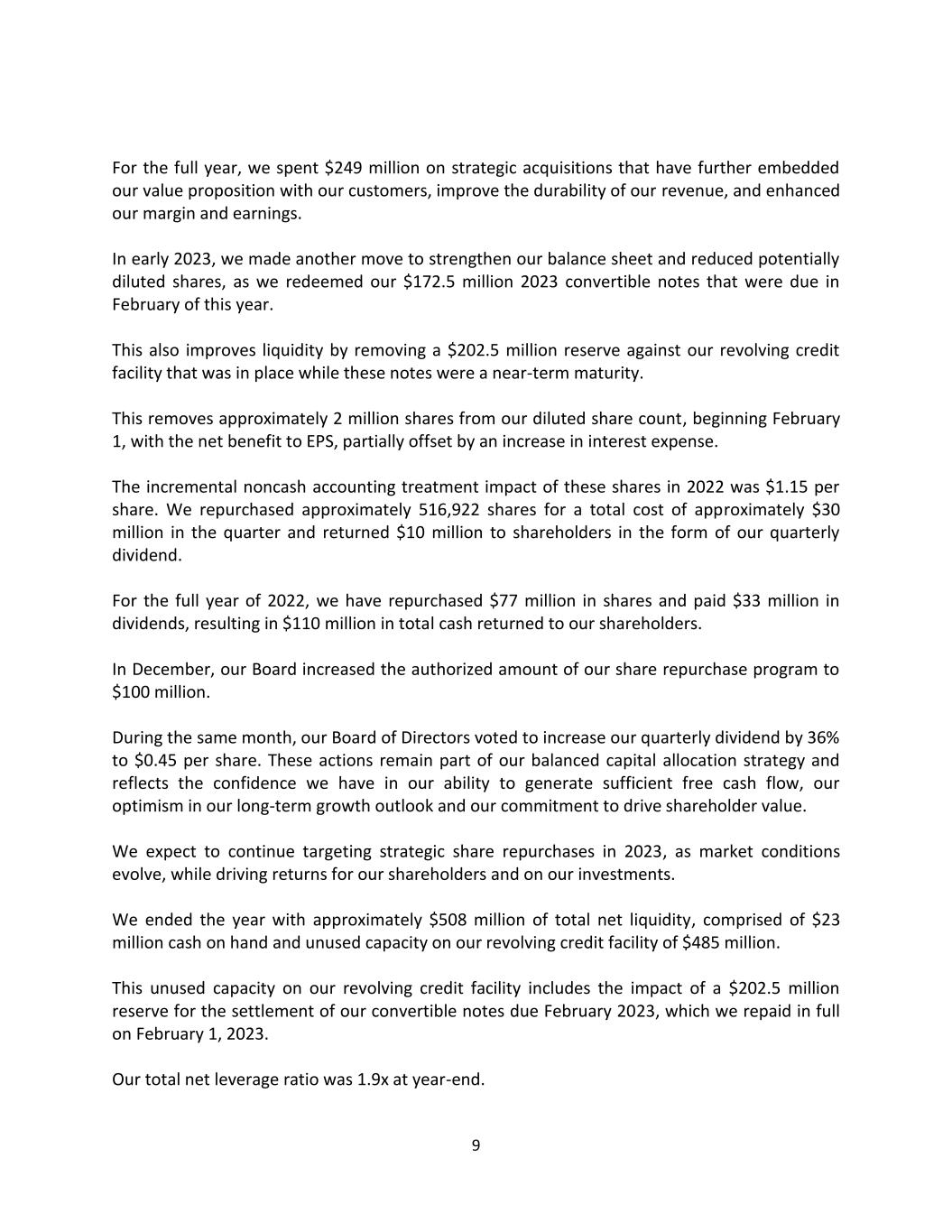
9 For the full year, we spent $249 million on strategic acquisitions that have further embedded our value proposition with our customers, improve the durability of our revenue, and enhanced our margin and earnings. In early 2023, we made another move to strengthen our balance sheet and reduced potentially diluted shares, as we redeemed our $172.5 million 2023 convertible notes that were due in February of this year. This also improves liquidity by removing a $202.5 million reserve against our revolving credit facility that was in place while these notes were a near-term maturity. This removes approximately 2 million shares from our diluted share count, beginning February 1, with the net benefit to EPS, partially offset by an increase in interest expense. The incremental noncash accounting treatment impact of these shares in 2022 was $1.15 per share. We repurchased approximately 516,922 shares for a total cost of approximately $30 million in the quarter and returned $10 million to shareholders in the form of our quarterly dividend. For the full year of 2022, we have repurchased $77 million in shares and paid $33 million in dividends, resulting in $110 million in total cash returned to our shareholders. In December, our Board increased the authorized amount of our share repurchase program to $100 million. During the same month, our Board of Directors voted to increase our quarterly dividend by 36% to $0.45 per share. These actions remain part of our balanced capital allocation strategy and reflects the confidence we have in our ability to generate sufficient free cash flow, our optimism in our long-term growth outlook and our commitment to drive shareholder value. We expect to continue targeting strategic share repurchases in 2023, as market conditions evolve, while driving returns for our shareholders and on our investments. We ended the year with approximately $508 million of total net liquidity, comprised of $23 million cash on hand and unused capacity on our revolving credit facility of $485 million. This unused capacity on our revolving credit facility includes the impact of a $202.5 million reserve for the settlement of our convertible notes due February 2023, which we repaid in full on February 1, 2023. Our total net leverage ratio was 1.9x at year-end.
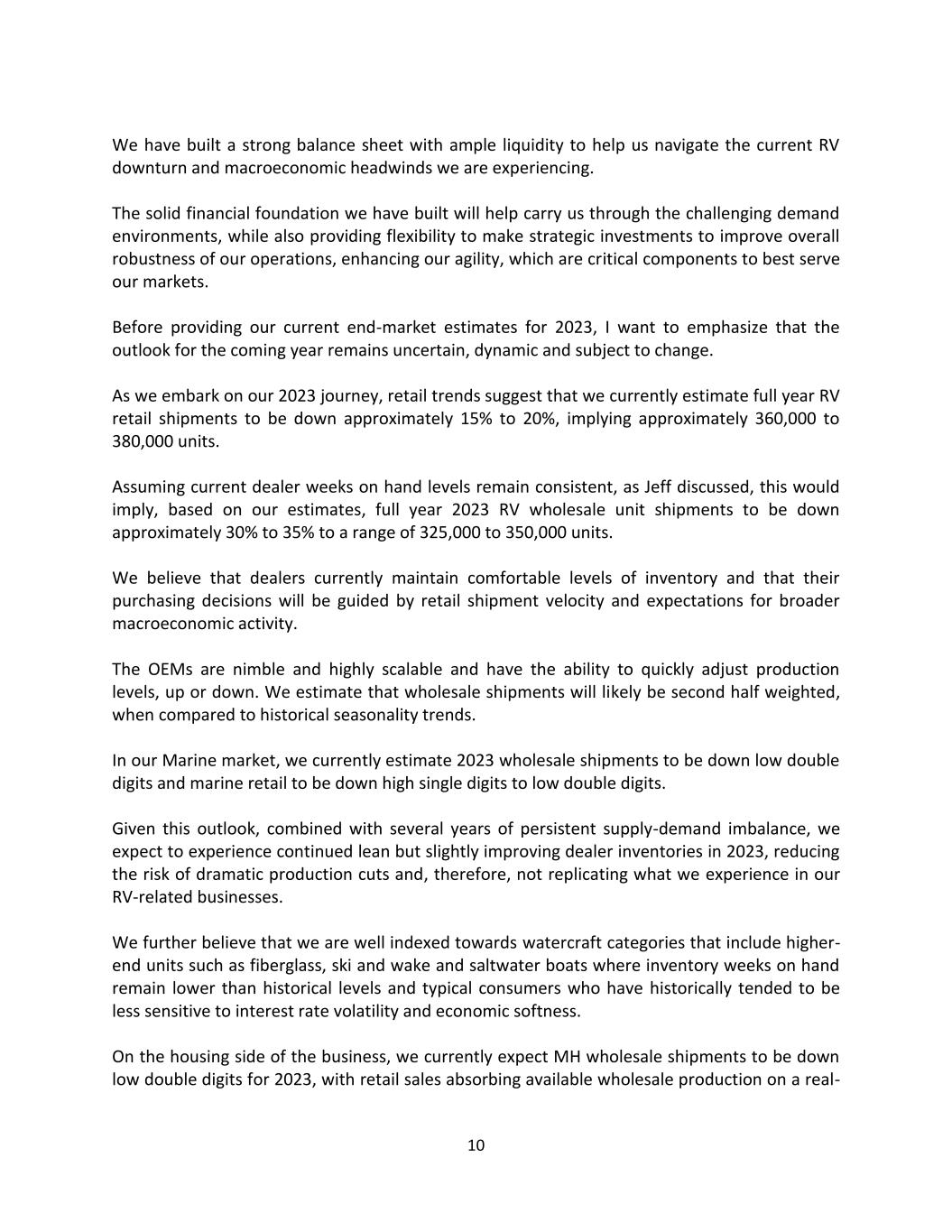
10 We have built a strong balance sheet with ample liquidity to help us navigate the current RV downturn and macroeconomic headwinds we are experiencing. The solid financial foundation we have built will help carry us through the challenging demand environments, while also providing flexibility to make strategic investments to improve overall robustness of our operations, enhancing our agility, which are critical components to best serve our markets. Before providing our current end-market estimates for 2023, I want to emphasize that the outlook for the coming year remains uncertain, dynamic and subject to change. As we embark on our 2023 journey, retail trends suggest that we currently estimate full year RV retail shipments to be down approximately 15% to 20%, implying approximately 360,000 to 380,000 units. Assuming current dealer weeks on hand levels remain consistent, as Jeff discussed, this would imply, based on our estimates, full year 2023 RV wholesale unit shipments to be down approximately 30% to 35% to a range of 325,000 to 350,000 units. We believe that dealers currently maintain comfortable levels of inventory and that their purchasing decisions will be guided by retail shipment velocity and expectations for broader macroeconomic activity. The OEMs are nimble and highly scalable and have the ability to quickly adjust production levels, up or down. We estimate that wholesale shipments will likely be second half weighted, when compared to historical seasonality trends. In our Marine market, we currently estimate 2023 wholesale shipments to be down low double digits and marine retail to be down high single digits to low double digits. Given this outlook, combined with several years of persistent supply-demand imbalance, we expect to experience continued lean but slightly improving dealer inventories in 2023, reducing the risk of dramatic production cuts and, therefore, not replicating what we experience in our RV-related businesses. We further believe that we are well indexed towards watercraft categories that include higher- end units such as fiberglass, ski and wake and saltwater boats where inventory weeks on hand remain lower than historical levels and typical consumers who have historically tended to be less sensitive to interest rate volatility and economic softness. On the housing side of the business, we currently expect MH wholesale shipments to be down low double digits for 2023, with retail sales absorbing available wholesale production on a real-
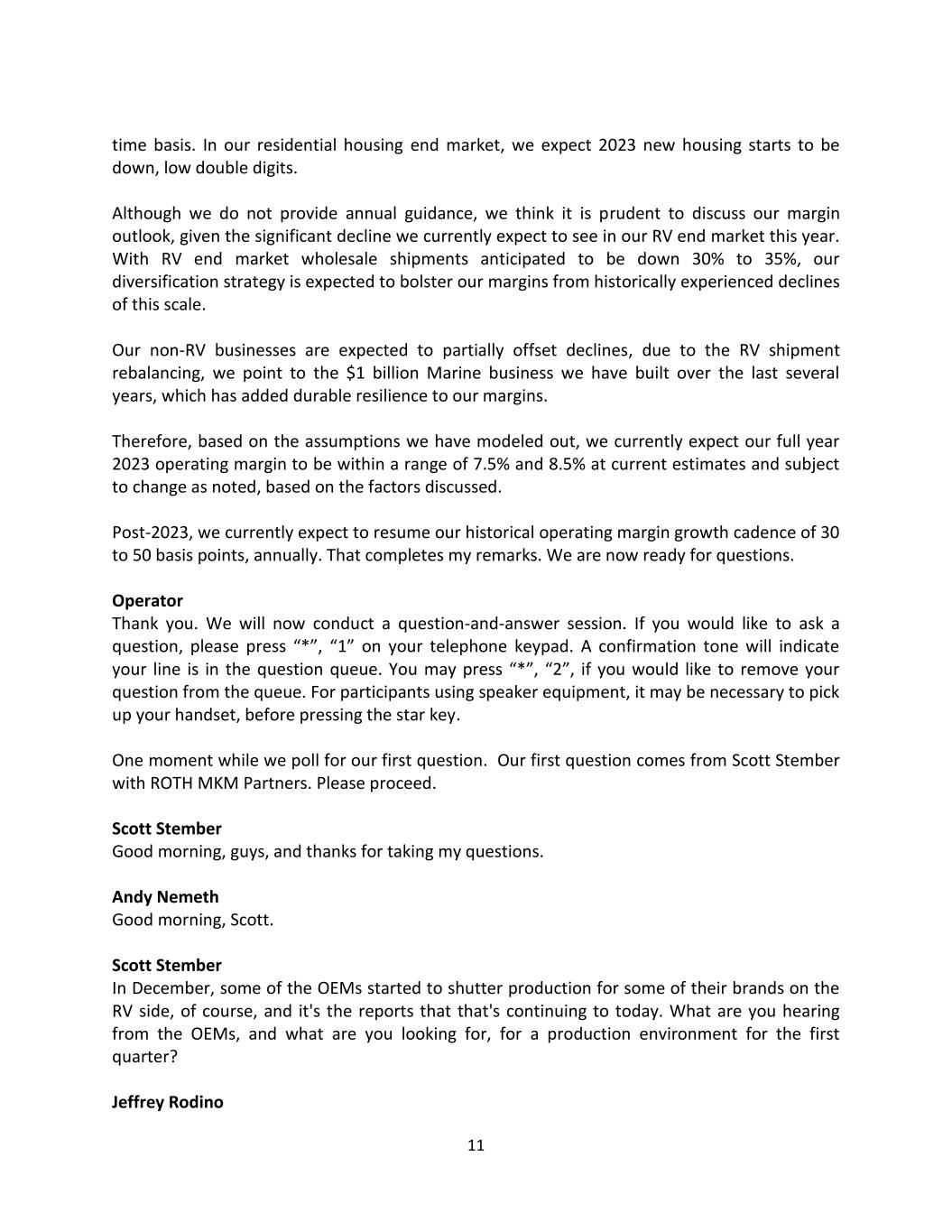
11 time basis. In our residential housing end market, we expect 2023 new housing starts to be down, low double digits. Although we do not provide annual guidance, we think it is prudent to discuss our margin outlook, given the significant decline we currently expect to see in our RV end market this year. With RV end market wholesale shipments anticipated to be down 30% to 35%, our diversification strategy is expected to bolster our margins from historically experienced declines of this scale. Our non-RV businesses are expected to partially offset declines, due to the RV shipment rebalancing, we point to the $1 billion Marine business we have built over the last several years, which has added durable resilience to our margins. Therefore, based on the assumptions we have modeled out, we currently expect our full year 2023 operating margin to be within a range of 7.5% and 8.5% at current estimates and subject to change as noted, based on the factors discussed. Post-2023, we currently expect to resume our historical operating margin growth cadence of 30 to 50 basis points, annually. That completes my remarks. We are now ready for questions. Operator Thank you. We will now conduct a question-and-answer session. If you would like to ask a question, please press “*”, “1” on your telephone keypad. A confirmation tone will indicate your line is in the question queue. You may press “*”, “2”, if you would like to remove your question from the queue. For participants using speaker equipment, it may be necessary to pick up your handset, before pressing the star key. One moment while we poll for our first question. Our first question comes from Scott Stember with ROTH MKM Partners. Please proceed. Scott Stember Good morning, guys, and thanks for taking my questions. Andy Nemeth Good morning, Scott. Scott Stember In December, some of the OEMs started to shutter production for some of their brands on the RV side, of course, and it's the reports that that's continuing to today. What are you hearing from the OEMs, and what are you looking for, for a production environment for the first quarter? Jeffrey Rodino

12 Yeah, Scott, this is Jeff. So, I don't--I'll say this. I don't know that they've shuttered brands because that's a little bit different than actually slowing production and taking kind of days and weeks off. We continue to see that through the holiday shutdown, some may be a little bit longer extended than we've seen in the past. However, the manufacturers are starting to come back online and have over the last several weeks. I will tell you that we still see the 3-day weeks and the occasional week off. But ultimately, we're seeing kind of similar activity that we saw pre-holiday production levels. Scott Stember Got it. And then if I heard you correct, in talking about your expectations for wholesale and retail, I guess, retail 360 plus in wholesale in that 325 to 350. That's the first time that a lot of us are hearing that there'll be a divergence between wholesale and retail, this year. Can you maybe talk about what's going on, as far as inventory, if you still feel that there's far too much inventory, particularly lower-priced units for '22 in the channel? Jake Petkovich Scott, this is Jake. Inventory still feels pretty healthy as measured by total units, weeks on hand, some of those additional measures that we've used and talked about in days past, but it still feels like there's at least from an anecdotal perspective and our connectivity with the dealer networks, that there's a desire to kind of continue to rebalance the types of units they have from maybe the lower end travel trailers to the higher end fifth wheels and motorized where there's a little more velocity, these days. But also as they think about clearing out some of the 2022 models, which we also heard a little bit at the Tampa show that they may be a little heavier on the '22 models than they'd like to be, at this time of the year. But also, generally speaking, thinking about continuing to work on that retail-driven kind of philosophy and how we use the analytics to build our model out, which is what leads us to that 325 to 350. And we think about where retail has been, and we use that as kind of the starting place, and if you think about this from second half '21 to second half '22 or fourth quarter to fourth quarter, we're down about 20%. And that kind of guides where we are for, at least, the very base of building the models that we use for these analytics. Then we start to work in and holding our constant weeks on hand. And as Jeff mentioned in his remarks, about 19 to 21 weeks, we think that's where people are generally comfortable and where that rebalancing activity will take place.
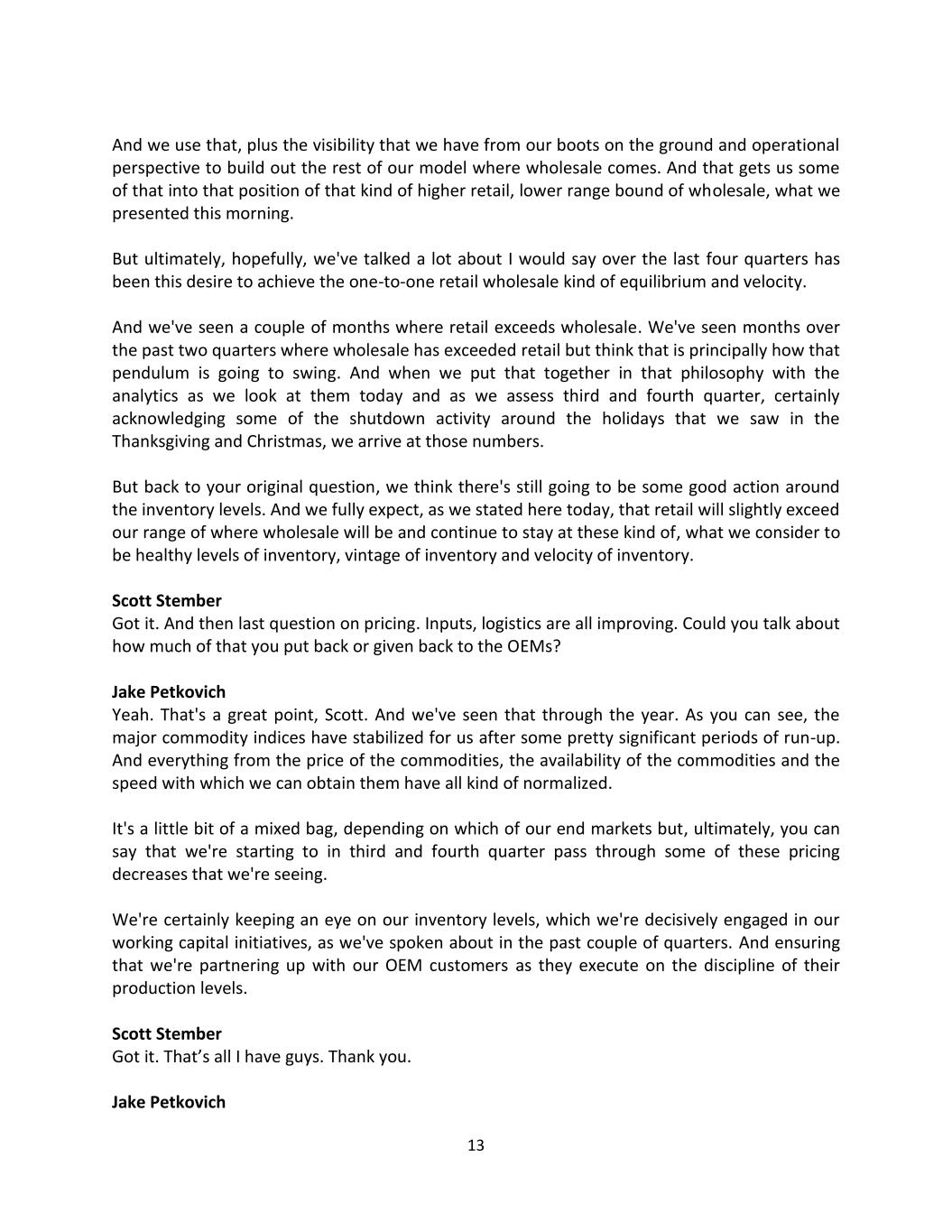
13 And we use that, plus the visibility that we have from our boots on the ground and operational perspective to build out the rest of our model where wholesale comes. And that gets us some of that into that position of that kind of higher retail, lower range bound of wholesale, what we presented this morning. But ultimately, hopefully, we've talked a lot about I would say over the last four quarters has been this desire to achieve the one-to-one retail wholesale kind of equilibrium and velocity. And we've seen a couple of months where retail exceeds wholesale. We've seen months over the past two quarters where wholesale has exceeded retail but think that is principally how that pendulum is going to swing. And when we put that together in that philosophy with the analytics as we look at them today and as we assess third and fourth quarter, certainly acknowledging some of the shutdown activity around the holidays that we saw in the Thanksgiving and Christmas, we arrive at those numbers. But back to your original question, we think there's still going to be some good action around the inventory levels. And we fully expect, as we stated here today, that retail will slightly exceed our range of where wholesale will be and continue to stay at these kind of, what we consider to be healthy levels of inventory, vintage of inventory and velocity of inventory. Scott Stember Got it. And then last question on pricing. Inputs, logistics are all improving. Could you talk about how much of that you put back or given back to the OEMs? Jake Petkovich Yeah. That's a great point, Scott. And we've seen that through the year. As you can see, the major commodity indices have stabilized for us after some pretty significant periods of run-up. And everything from the price of the commodities, the availability of the commodities and the speed with which we can obtain them have all kind of normalized. It's a little bit of a mixed bag, depending on which of our end markets but, ultimately, you can say that we're starting to in third and fourth quarter pass through some of these pricing decreases that we're seeing. We're certainly keeping an eye on our inventory levels, which we're decisively engaged in our working capital initiatives, as we've spoken about in the past couple of quarters. And ensuring that we're partnering up with our OEM customers as they execute on the discipline of their production levels. Scott Stember Got it. That’s all I have guys. Thank you. Jake Petkovich
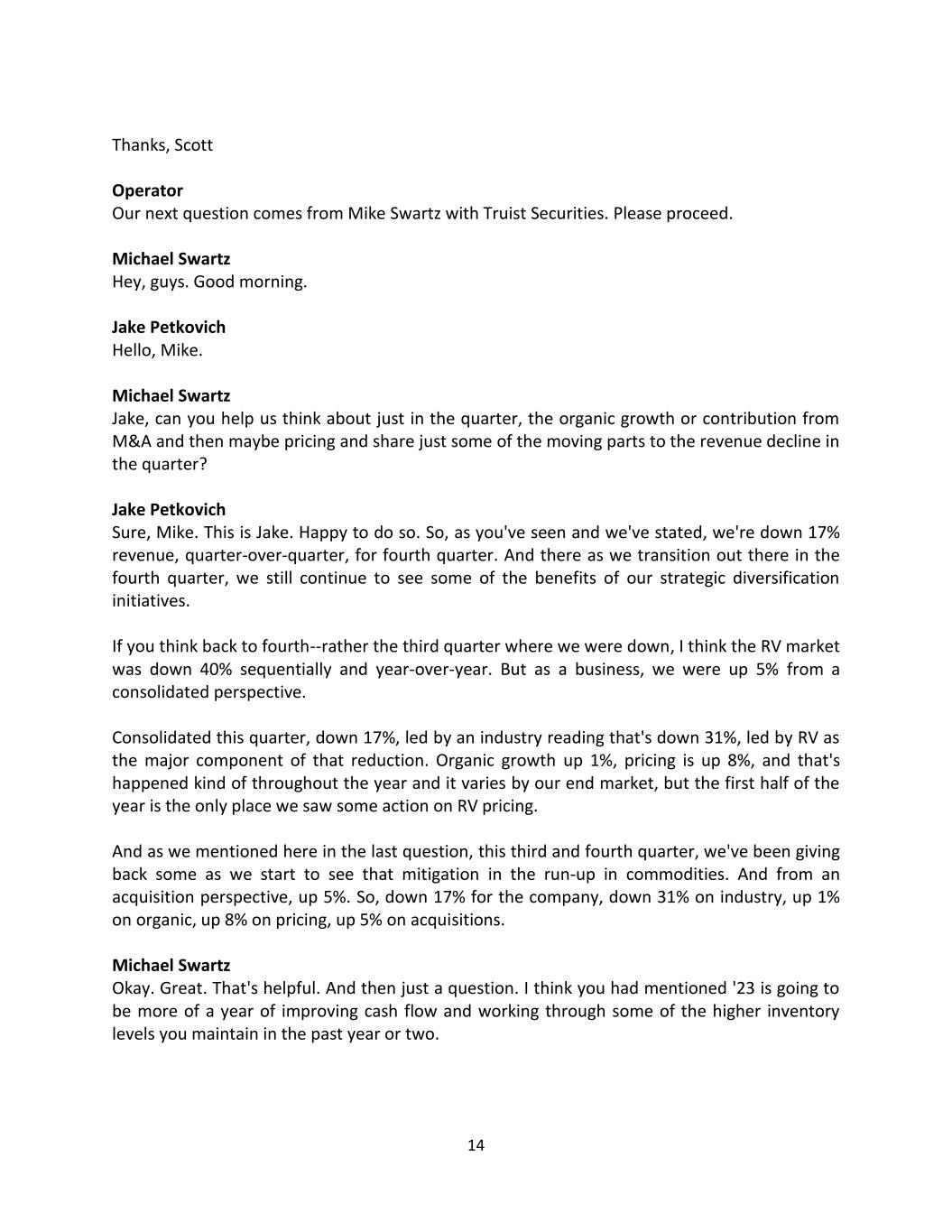
14 Thanks, Scott Operator Our next question comes from Mike Swartz with Truist Securities. Please proceed. Michael Swartz Hey, guys. Good morning. Jake Petkovich Hello, Mike. Michael Swartz Jake, can you help us think about just in the quarter, the organic growth or contribution from M&A and then maybe pricing and share just some of the moving parts to the revenue decline in the quarter? Jake Petkovich Sure, Mike. This is Jake. Happy to do so. So, as you've seen and we've stated, we're down 17% revenue, quarter-over-quarter, for fourth quarter. And there as we transition out there in the fourth quarter, we still continue to see some of the benefits of our strategic diversification initiatives. If you think back to fourth--rather the third quarter where we were down, I think the RV market was down 40% sequentially and year-over-year. But as a business, we were up 5% from a consolidated perspective. Consolidated this quarter, down 17%, led by an industry reading that's down 31%, led by RV as the major component of that reduction. Organic growth up 1%, pricing is up 8%, and that's happened kind of throughout the year and it varies by our end market, but the first half of the year is the only place we saw some action on RV pricing. And as we mentioned here in the last question, this third and fourth quarter, we've been giving back some as we start to see that mitigation in the run-up in commodities. And from an acquisition perspective, up 5%. So, down 17% for the company, down 31% on industry, up 1% on organic, up 8% on pricing, up 5% on acquisitions. Michael Swartz Okay. Great. That's helpful. And then just a question. I think you had mentioned '23 is going to be more of a year of improving cash flow and working through some of the higher inventory levels you maintain in the past year or two.
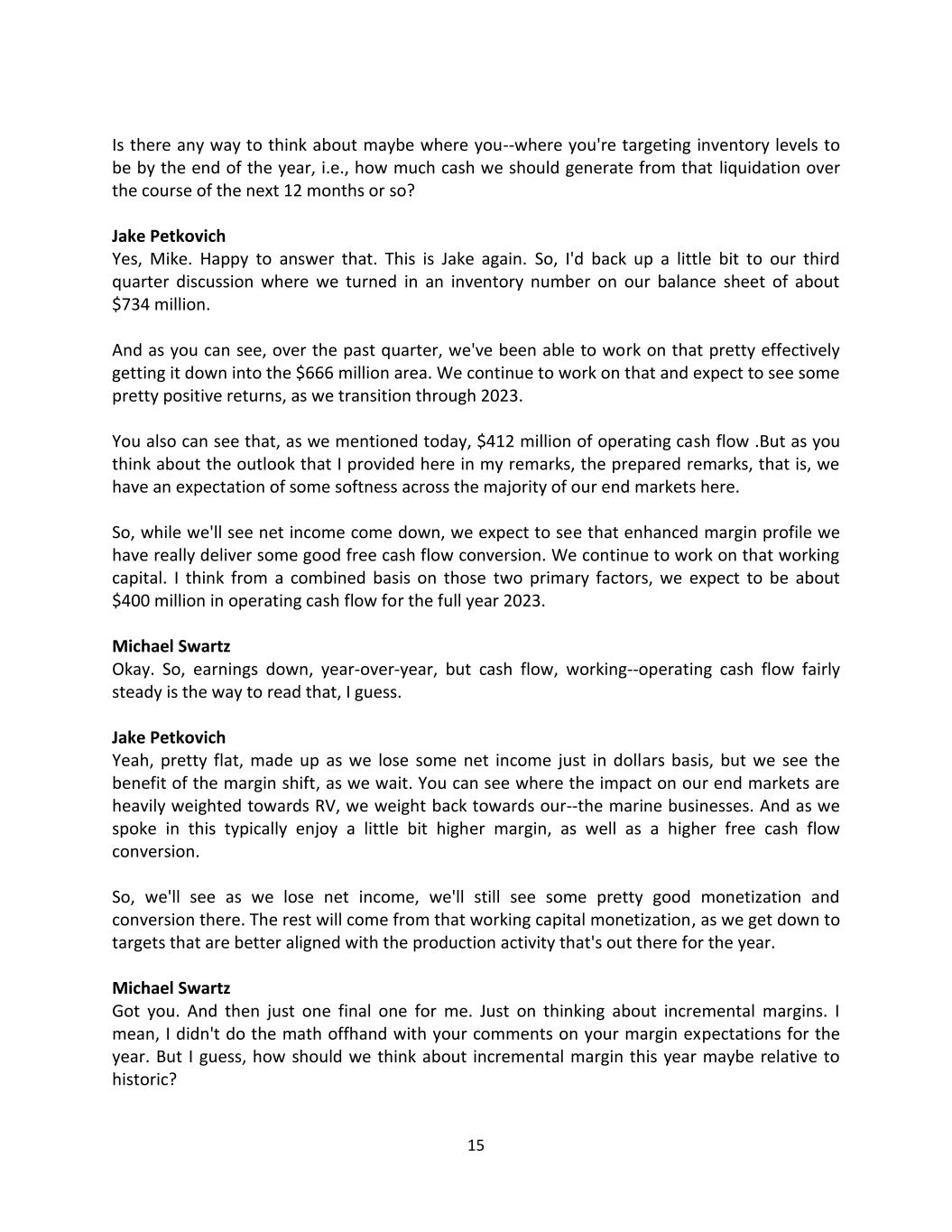
15 Is there any way to think about maybe where you--where you're targeting inventory levels to be by the end of the year, i.e., how much cash we should generate from that liquidation over the course of the next 12 months or so? Jake Petkovich Yes, Mike. Happy to answer that. This is Jake again. So, I'd back up a little bit to our third quarter discussion where we turned in an inventory number on our balance sheet of about $734 million. And as you can see, over the past quarter, we've been able to work on that pretty effectively getting it down into the $666 million area. We continue to work on that and expect to see some pretty positive returns, as we transition through 2023. You also can see that, as we mentioned today, $412 million of operating cash flow .But as you think about the outlook that I provided here in my remarks, the prepared remarks, that is, we have an expectation of some softness across the majority of our end markets here. So, while we'll see net income come down, we expect to see that enhanced margin profile we have really deliver some good free cash flow conversion. We continue to work on that working capital. I think from a combined basis on those two primary factors, we expect to be about $400 million in operating cash flow for the full year 2023. Michael Swartz Okay. So, earnings down, year-over-year, but cash flow, working--operating cash flow fairly steady is the way to read that, I guess. Jake Petkovich Yeah, pretty flat, made up as we lose some net income just in dollars basis, but we see the benefit of the margin shift, as we wait. You can see where the impact on our end markets are heavily weighted towards RV, we weight back towards our--the marine businesses. And as we spoke in this typically enjoy a little bit higher margin, as well as a higher free cash flow conversion. So, we'll see as we lose net income, we'll still see some pretty good monetization and conversion there. The rest will come from that working capital monetization, as we get down to targets that are better aligned with the production activity that's out there for the year. Michael Swartz Got you. And then just one final one for me. Just on thinking about incremental margins. I mean, I didn't do the math offhand with your comments on your margin expectations for the year. But I guess, how should we think about incremental margin this year maybe relative to historic?

16 And then how to think about that going forward in a lot of the automation, the efficiency initiatives that you've undertaken. Has that incremental margin math changed pretty significantly? Jake Petkovich Yeah, thanks, Mike. It's Jake again. And I would tell you it's a theme we've certainly spent a lot of time, and we, as a group on this call, have spoken about over the last couple of quarters and some of the primary contributors to our margin expansion, which has been significant this year, has been a couple of things. And it's the pricing, but certainly to be sure, as well as some absorption that we've seen on the higher production levels. But where we've spoken a lot in the last few quarters about the durability of that margin and where that comes from. And that's--we still believe in that 100 to 125 basis points of durable improvements, structural improvements to our business, 50 to 75-plus basis points of that coming from the acquisitions, which are smaller in their addition to the revenue, but certainly bring an outsized margin profile to us. And we think that contribution is the durability of that new product, higher value-added, higher fabrication. And certainly, as you know, a weight towards the marine side of the business. The rest comes of that 100 to 125 basis points really comes from efficiency, automation and human capital initiatives that we've engaged upon. And we see that, as we think back a little bit in time, to your point about some previous readings, Andy mentioned a few of those in his initial remarks where we did some comparison between 2017 and 2022. But as you think about--maybe you go back in time and you can go way back to the great recession, but not a great comparable for our company as that was--I think we were $200 to $300 million company at the time with a very different margin profile and product set. If you just think back to 2018, 2019, which was some overstocking and rebalancing in the RV business, which is the principal part of our business. Back in 2018, where only about 7% to 8% of our business was comprised of marine versus the 27% it is today. If you go back to 2018, 2019, where RV wholesale was down about 16%, which took it down to that 400,000 level, we lost about 130 basis points of margin and took us down in the mid-6% area. We think about that durable improvement, plus the starting point where we are at the 10.2% operating margin that we've worked very hard to achieve.
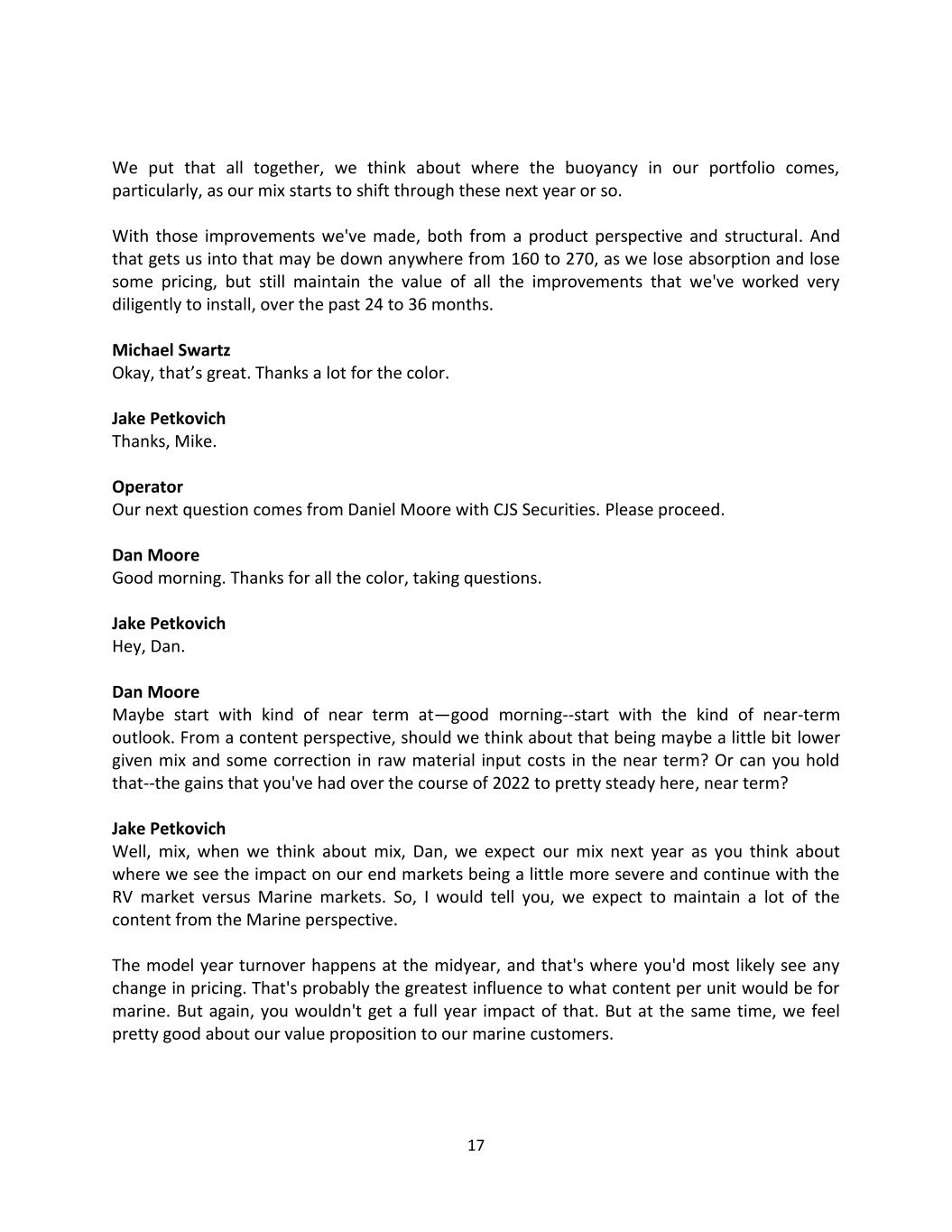
17 We put that all together, we think about where the buoyancy in our portfolio comes, particularly, as our mix starts to shift through these next year or so. With those improvements we've made, both from a product perspective and structural. And that gets us into that may be down anywhere from 160 to 270, as we lose absorption and lose some pricing, but still maintain the value of all the improvements that we've worked very diligently to install, over the past 24 to 36 months. Michael Swartz Okay, that’s great. Thanks a lot for the color. Jake Petkovich Thanks, Mike. Operator Our next question comes from Daniel Moore with CJS Securities. Please proceed. Dan Moore Good morning. Thanks for all the color, taking questions. Jake Petkovich Hey, Dan. Dan Moore Maybe start with kind of near term at—good morning--start with the kind of near-term outlook. From a content perspective, should we think about that being maybe a little bit lower given mix and some correction in raw material input costs in the near term? Or can you hold that--the gains that you've had over the course of 2022 to pretty steady here, near term? Jake Petkovich Well, mix, when we think about mix, Dan, we expect our mix next year as you think about where we see the impact on our end markets being a little more severe and continue with the RV market versus Marine markets. So, I would tell you, we expect to maintain a lot of the content from the Marine perspective. The model year turnover happens at the midyear, and that's where you'd most likely see any change in pricing. That's probably the greatest influence to what content per unit would be for marine. But again, you wouldn't get a full year impact of that. But at the same time, we feel pretty good about our value proposition to our marine customers.
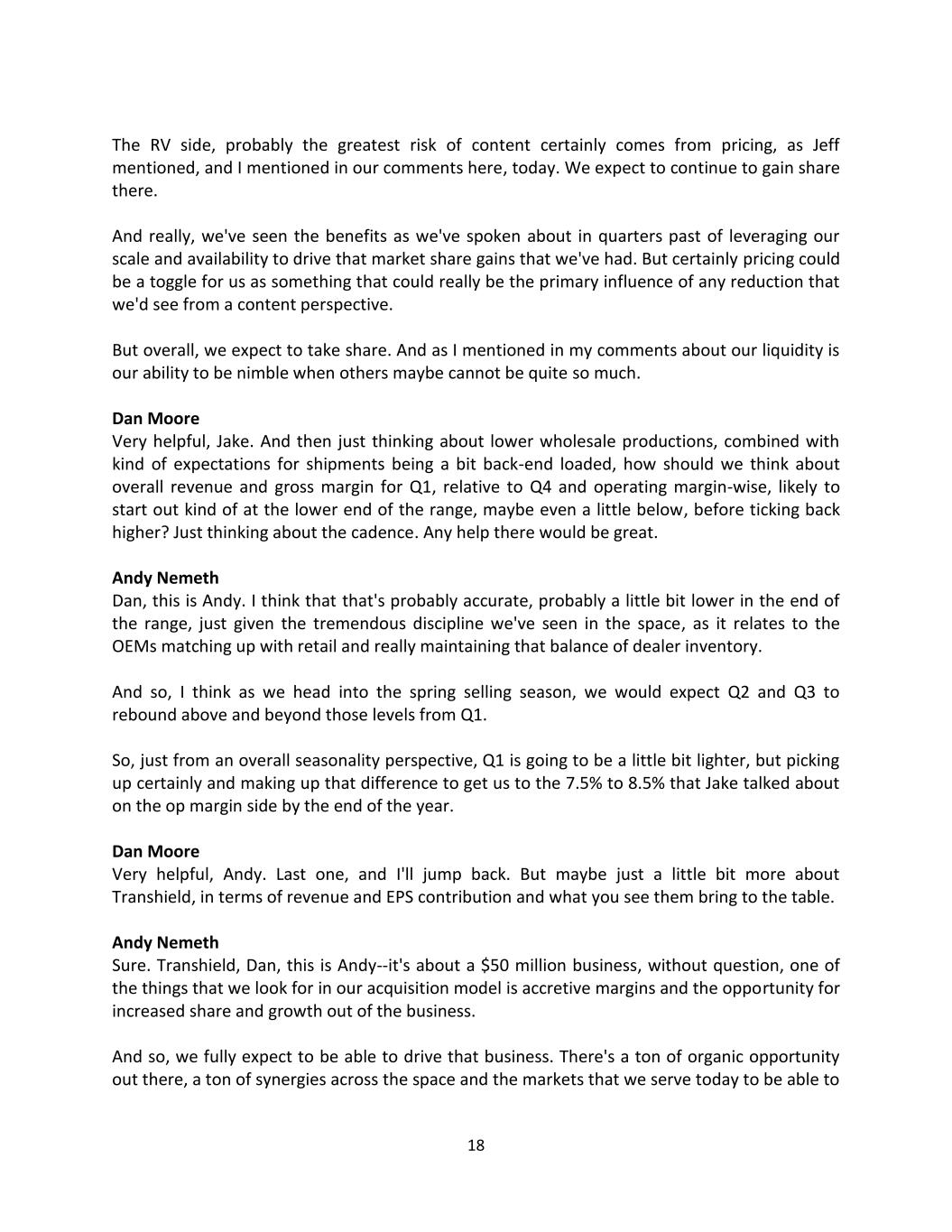
18 The RV side, probably the greatest risk of content certainly comes from pricing, as Jeff mentioned, and I mentioned in our comments here, today. We expect to continue to gain share there. And really, we've seen the benefits as we've spoken about in quarters past of leveraging our scale and availability to drive that market share gains that we've had. But certainly pricing could be a toggle for us as something that could really be the primary influence of any reduction that we'd see from a content perspective. But overall, we expect to take share. And as I mentioned in my comments about our liquidity is our ability to be nimble when others maybe cannot be quite so much. Dan Moore Very helpful, Jake. And then just thinking about lower wholesale productions, combined with kind of expectations for shipments being a bit back-end loaded, how should we think about overall revenue and gross margin for Q1, relative to Q4 and operating margin-wise, likely to start out kind of at the lower end of the range, maybe even a little below, before ticking back higher? Just thinking about the cadence. Any help there would be great. Andy Nemeth Dan, this is Andy. I think that that's probably accurate, probably a little bit lower in the end of the range, just given the tremendous discipline we've seen in the space, as it relates to the OEMs matching up with retail and really maintaining that balance of dealer inventory. And so, I think as we head into the spring selling season, we would expect Q2 and Q3 to rebound above and beyond those levels from Q1. So, just from an overall seasonality perspective, Q1 is going to be a little bit lighter, but picking up certainly and making up that difference to get us to the 7.5% to 8.5% that Jake talked about on the op margin side by the end of the year. Dan Moore Very helpful, Andy. Last one, and I'll jump back. But maybe just a little bit more about Transhield, in terms of revenue and EPS contribution and what you see them bring to the table. Andy Nemeth Sure. Transhield, Dan, this is Andy--it's about a $50 million business, without question, one of the things that we look for in our acquisition model is accretive margins and the opportunity for increased share and growth out of the business. And so, we fully expect to be able to drive that business. There's a ton of organic opportunity out there, a ton of synergies across the space and the markets that we serve today to be able to
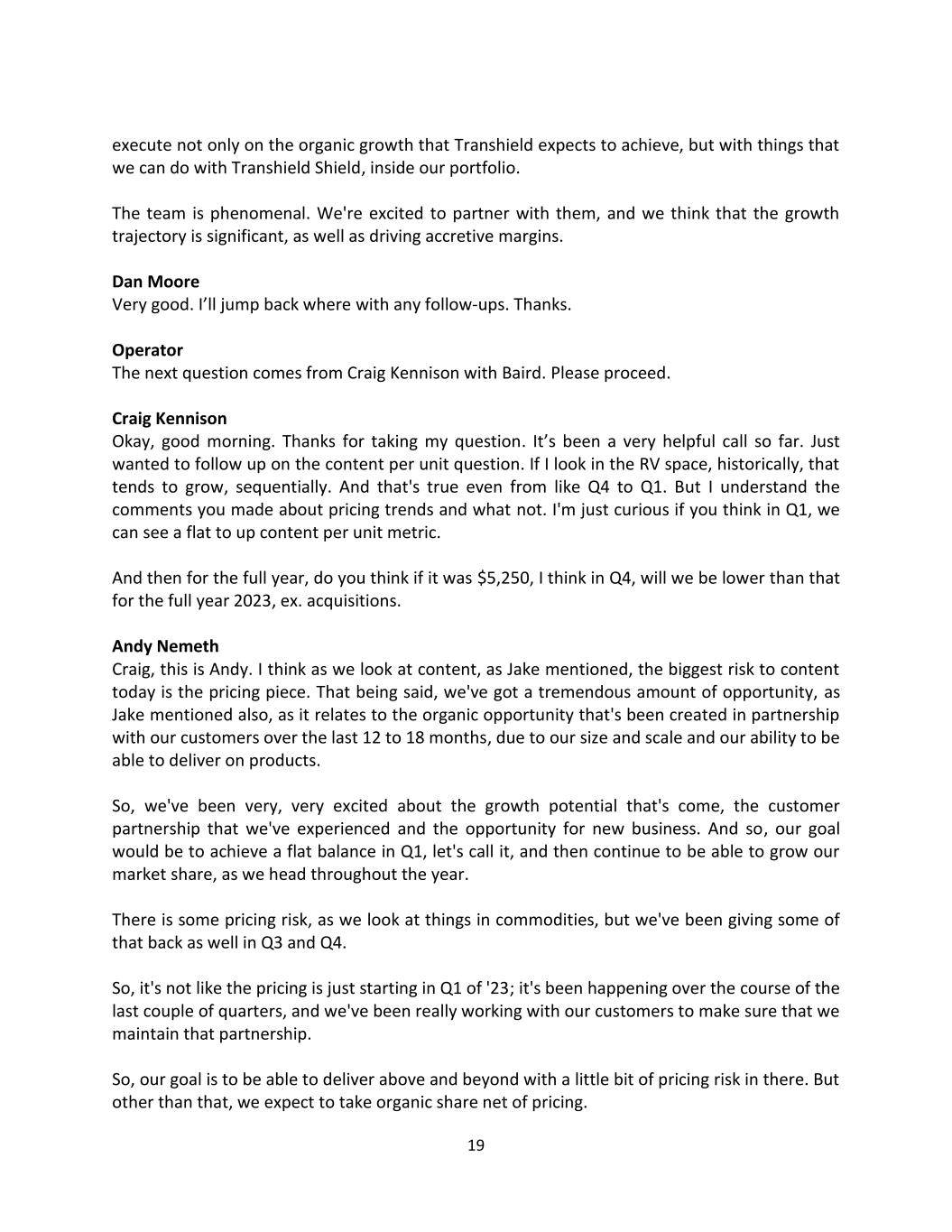
19 execute not only on the organic growth that Transhield expects to achieve, but with things that we can do with Transhield Shield, inside our portfolio. The team is phenomenal. We're excited to partner with them, and we think that the growth trajectory is significant, as well as driving accretive margins. Dan Moore Very good. I’ll jump back where with any follow-ups. Thanks. Operator The next question comes from Craig Kennison with Baird. Please proceed. Craig Kennison Okay, good morning. Thanks for taking my question. It’s been a very helpful call so far. Just wanted to follow up on the content per unit question. If I look in the RV space, historically, that tends to grow, sequentially. And that's true even from like Q4 to Q1. But I understand the comments you made about pricing trends and what not. I'm just curious if you think in Q1, we can see a flat to up content per unit metric. And then for the full year, do you think if it was $5,250, I think in Q4, will we be lower than that for the full year 2023, ex. acquisitions. Andy Nemeth Craig, this is Andy. I think as we look at content, as Jake mentioned, the biggest risk to content today is the pricing piece. That being said, we've got a tremendous amount of opportunity, as Jake mentioned also, as it relates to the organic opportunity that's been created in partnership with our customers over the last 12 to 18 months, due to our size and scale and our ability to be able to deliver on products. So, we've been very, very excited about the growth potential that's come, the customer partnership that we've experienced and the opportunity for new business. And so, our goal would be to achieve a flat balance in Q1, let's call it, and then continue to be able to grow our market share, as we head throughout the year. There is some pricing risk, as we look at things in commodities, but we've been giving some of that back as well in Q3 and Q4. So, it's not like the pricing is just starting in Q1 of '23; it's been happening over the course of the last couple of quarters, and we've been really working with our customers to make sure that we maintain that partnership. So, our goal is to be able to deliver above and beyond with a little bit of pricing risk in there. But other than that, we expect to take organic share net of pricing.
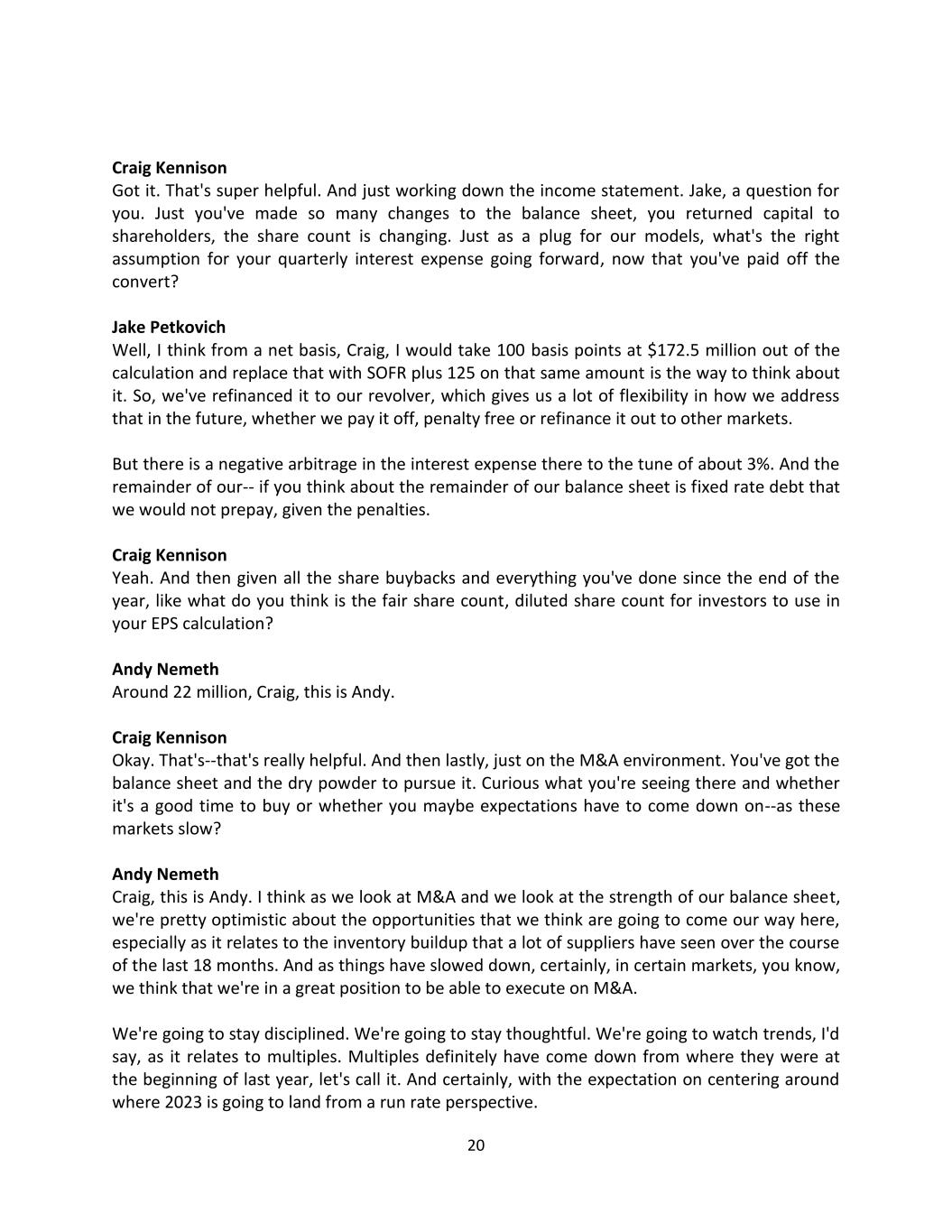
20 Craig Kennison Got it. That's super helpful. And just working down the income statement. Jake, a question for you. Just you've made so many changes to the balance sheet, you returned capital to shareholders, the share count is changing. Just as a plug for our models, what's the right assumption for your quarterly interest expense going forward, now that you've paid off the convert? Jake Petkovich Well, I think from a net basis, Craig, I would take 100 basis points at $172.5 million out of the calculation and replace that with SOFR plus 125 on that same amount is the way to think about it. So, we've refinanced it to our revolver, which gives us a lot of flexibility in how we address that in the future, whether we pay it off, penalty free or refinance it out to other markets. But there is a negative arbitrage in the interest expense there to the tune of about 3%. And the remainder of our-- if you think about the remainder of our balance sheet is fixed rate debt that we would not prepay, given the penalties. Craig Kennison Yeah. And then given all the share buybacks and everything you've done since the end of the year, like what do you think is the fair share count, diluted share count for investors to use in your EPS calculation? Andy Nemeth Around 22 million, Craig, this is Andy. Craig Kennison Okay. That's--that's really helpful. And then lastly, just on the M&A environment. You've got the balance sheet and the dry powder to pursue it. Curious what you're seeing there and whether it's a good time to buy or whether you maybe expectations have to come down on--as these markets slow? Andy Nemeth Craig, this is Andy. I think as we look at M&A and we look at the strength of our balance sheet, we're pretty optimistic about the opportunities that we think are going to come our way here, especially as it relates to the inventory buildup that a lot of suppliers have seen over the course of the last 18 months. And as things have slowed down, certainly, in certain markets, you know, we think that we're in a great position to be able to execute on M&A. We're going to stay disciplined. We're going to stay thoughtful. We're going to watch trends, I'd say, as it relates to multiples. Multiples definitely have come down from where they were at the beginning of last year, let's call it. And certainly, with the expectation on centering around where 2023 is going to land from a run rate perspective.

21 So, we're in a great position to be able to execute on M&A. We're currently evaluating deals. And--but we're going to stay disciplined and thoughtful about it, and we're going to kind of watch what happens. But overall, I really like where we're at. Craig Kennison Great. Okay, thank you so much. Andy Nemeth Thank you. Operator Our next question comes from Rafe Jadrosich with Bank of America. Please proceed. Rafe Jadrosich Hi, good morning, it’s Rafe, thanks for taking my question. Just the first one, I just wanted to follow up on some of the comments on commodities and pricing. Can you just first remind us kind of where you have the largest exposure in terms of commodities, like the mix has changed in your business-like RV or some other categories? So, what are the biggest commodity exposures that you have right now? And has it changed? Jeffrey Rodino Yeah, Rafe, this is Jeff. Plywood and particleboard in kind of different wood paneling is probably one of our biggest exposures out there in the market. We certainly deal quite a bit in the aluminum space and different resin-related products and copper. But certainly, by far, wood is probably the biggest commodity that we look at. Rafe Jadrosich And then how should we think about the timing lag of raw material inflation or deflation and how long it takes to flow through your P&L compared to when it changes the pricing to your customers? Jeffrey Rodino Rafe, this is Jeff again. It really is dependent on the specific commodity and within those commodity ranges, specific product lines. Certainly, we're flowing those through to the customer, as we are certainly able to with the inventory levels that we may or may not have in queue at the time. But ultimately, especially when we're looking at wood, we're passing below those along real time. There are some different commodities that we are a little bit heavier on coming out of 2022 and into 2023. But we're very mindful of getting through those quickly and passing those decreases along.
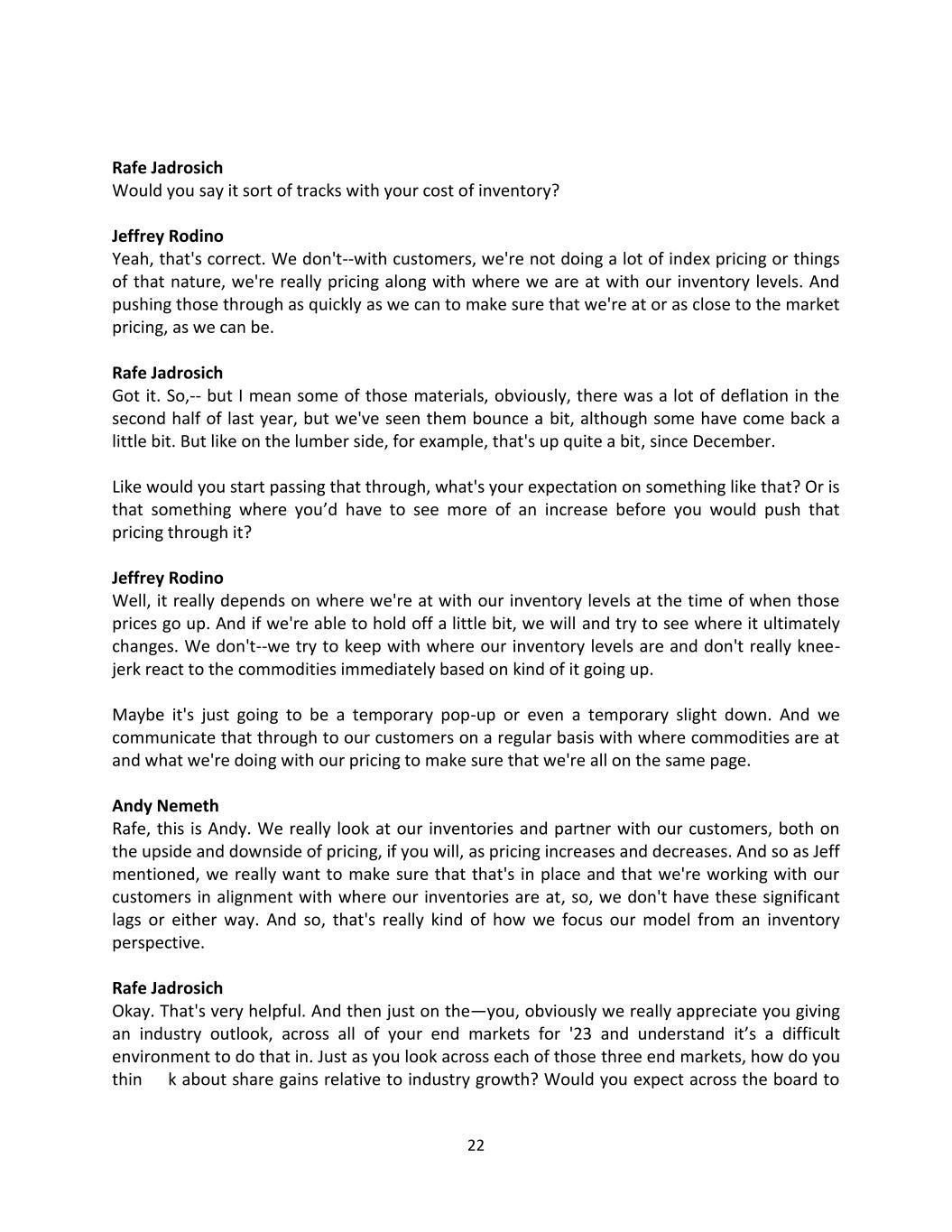
22 Rafe Jadrosich Would you say it sort of tracks with your cost of inventory? Jeffrey Rodino Yeah, that's correct. We don't--with customers, we're not doing a lot of index pricing or things of that nature, we're really pricing along with where we are at with our inventory levels. And pushing those through as quickly as we can to make sure that we're at or as close to the market pricing, as we can be. Rafe Jadrosich Got it. So,-- but I mean some of those materials, obviously, there was a lot of deflation in the second half of last year, but we've seen them bounce a bit, although some have come back a little bit. But like on the lumber side, for example, that's up quite a bit, since December. Like would you start passing that through, what's your expectation on something like that? Or is that something where you’d have to see more of an increase before you would push that pricing through it? Jeffrey Rodino Well, it really depends on where we're at with our inventory levels at the time of when those prices go up. And if we're able to hold off a little bit, we will and try to see where it ultimately changes. We don't--we try to keep with where our inventory levels are and don't really knee- jerk react to the commodities immediately based on kind of it going up. Maybe it's just going to be a temporary pop-up or even a temporary slight down. And we communicate that through to our customers on a regular basis with where commodities are at and what we're doing with our pricing to make sure that we're all on the same page. Andy Nemeth Rafe, this is Andy. We really look at our inventories and partner with our customers, both on the upside and downside of pricing, if you will, as pricing increases and decreases. And so as Jeff mentioned, we really want to make sure that that's in place and that we're working with our customers in alignment with where our inventories are at, so, we don't have these significant lags or either way. And so, that's really kind of how we focus our model from an inventory perspective. Rafe Jadrosich Okay. That's very helpful. And then just on the—you, obviously we really appreciate you giving an industry outlook, across all of your end markets for '23 and understand it’s a difficult environment to do that in. Just as you look across each of those three end markets, how do you thin k about share gains relative to industry growth? Would you expect across the board to
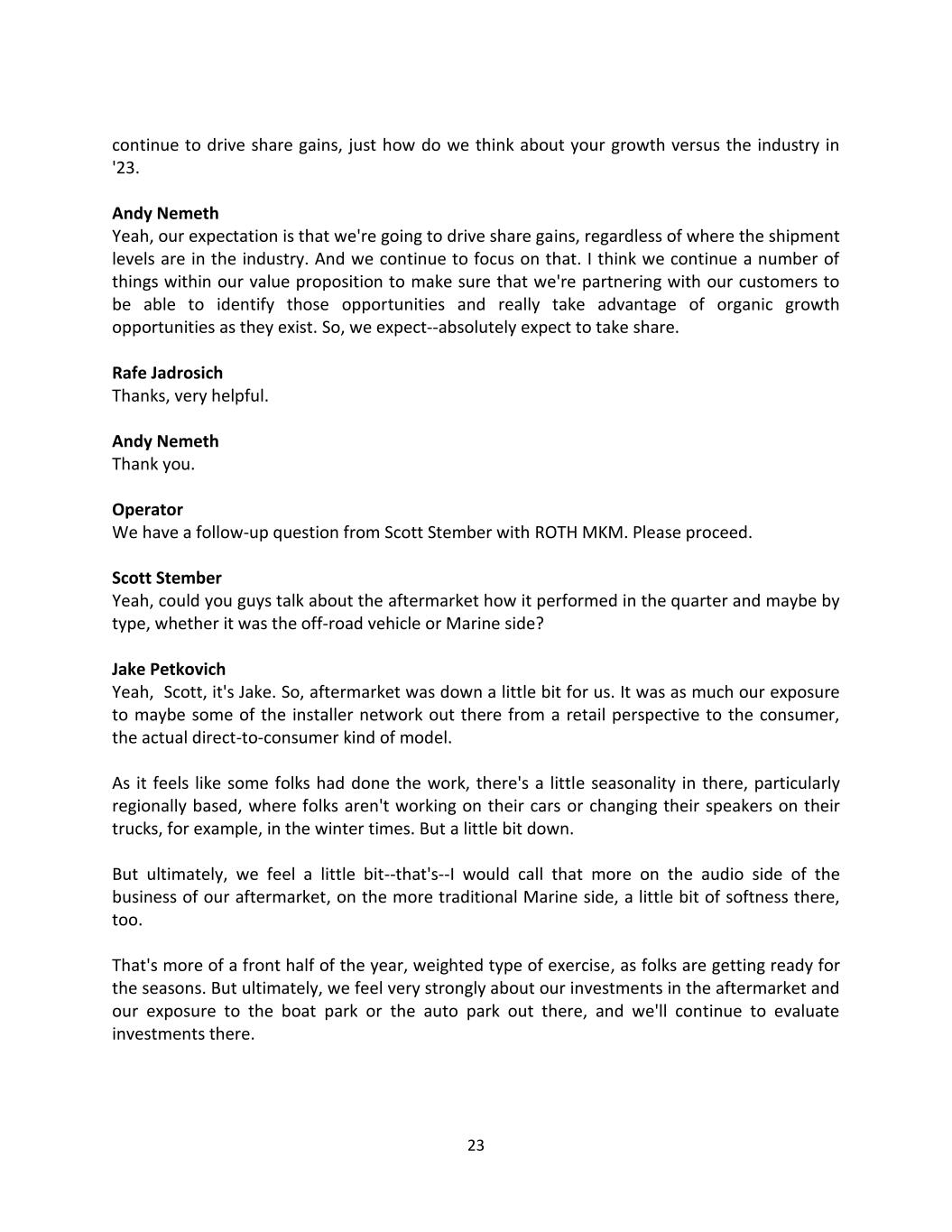
23 continue to drive share gains, just how do we think about your growth versus the industry in '23. Andy Nemeth Yeah, our expectation is that we're going to drive share gains, regardless of where the shipment levels are in the industry. And we continue to focus on that. I think we continue a number of things within our value proposition to make sure that we're partnering with our customers to be able to identify those opportunities and really take advantage of organic growth opportunities as they exist. So, we expect--absolutely expect to take share. Rafe Jadrosich Thanks, very helpful. Andy Nemeth Thank you. Operator We have a follow-up question from Scott Stember with ROTH MKM. Please proceed. Scott Stember Yeah, could you guys talk about the aftermarket how it performed in the quarter and maybe by type, whether it was the off-road vehicle or Marine side? Jake Petkovich Yeah, Scott, it's Jake. So, aftermarket was down a little bit for us. It was as much our exposure to maybe some of the installer network out there from a retail perspective to the consumer, the actual direct-to-consumer kind of model. As it feels like some folks had done the work, there's a little seasonality in there, particularly regionally based, where folks aren't working on their cars or changing their speakers on their trucks, for example, in the winter times. But a little bit down. But ultimately, we feel a little bit--that's--I would call that more on the audio side of the business of our aftermarket, on the more traditional Marine side, a little bit of softness there, too. That's more of a front half of the year, weighted type of exercise, as folks are getting ready for the seasons. But ultimately, we feel very strongly about our investments in the aftermarket and our exposure to the boat park or the auto park out there, and we'll continue to evaluate investments there.

24 Andy Nemeth Yeah, Scott, this is Andy. I want to just add a little bit there as well. I think as we look at some potential softening as it relates to just overall wholesale units, we would expect the aftermarket to kick back in a little bit, as consumers continue to spend on upgrades and things like that. So, we're optimistic about where the aftermarket is going to head for '23, given the strength that we saw in the first half of '22, a little bit of lag in the back half of '22, but into '23 coupled with that decline, let's call it, in just wholesale units as a whole, we would expect aftermarket to perform better. Scott Stember Got it. Andy Nemeth Thank you. Operator Thank you, ladies and gentlemen, I will turn it over to Andy for closing remarks. Andy Nemeth Thank you. I want to conclude our call by recognizing the outstanding contributions of the Patrick team. While market dynamics have changed over the last 12 months, the performance and dedication of our team members has not wavered. United behind our core values, our team demonstrates the power of our Better Together culture. As we enter 2023, we are confident in our team's ability to navigate the challenges ahead and execute on our strategy and vision. Thank you for joining us, today. Operator Thank you, ladies and gentlemen. This concludes today's teleconference. Thank you for participating, and you may now disconnect your lines. Editor Company Disclaimer This transcript contains certain statements related to future results, our intentions, beliefs and expectations or predictions for the future, which are forward-looking statements as that term is defined in the Private Securities Litigation Reform Act of 1995. These forward-looking statements involve a number of risks and uncertainties that could cause actual results to differ materially from either historical or anticipated results depending on a variety of factors. Potential factors that could
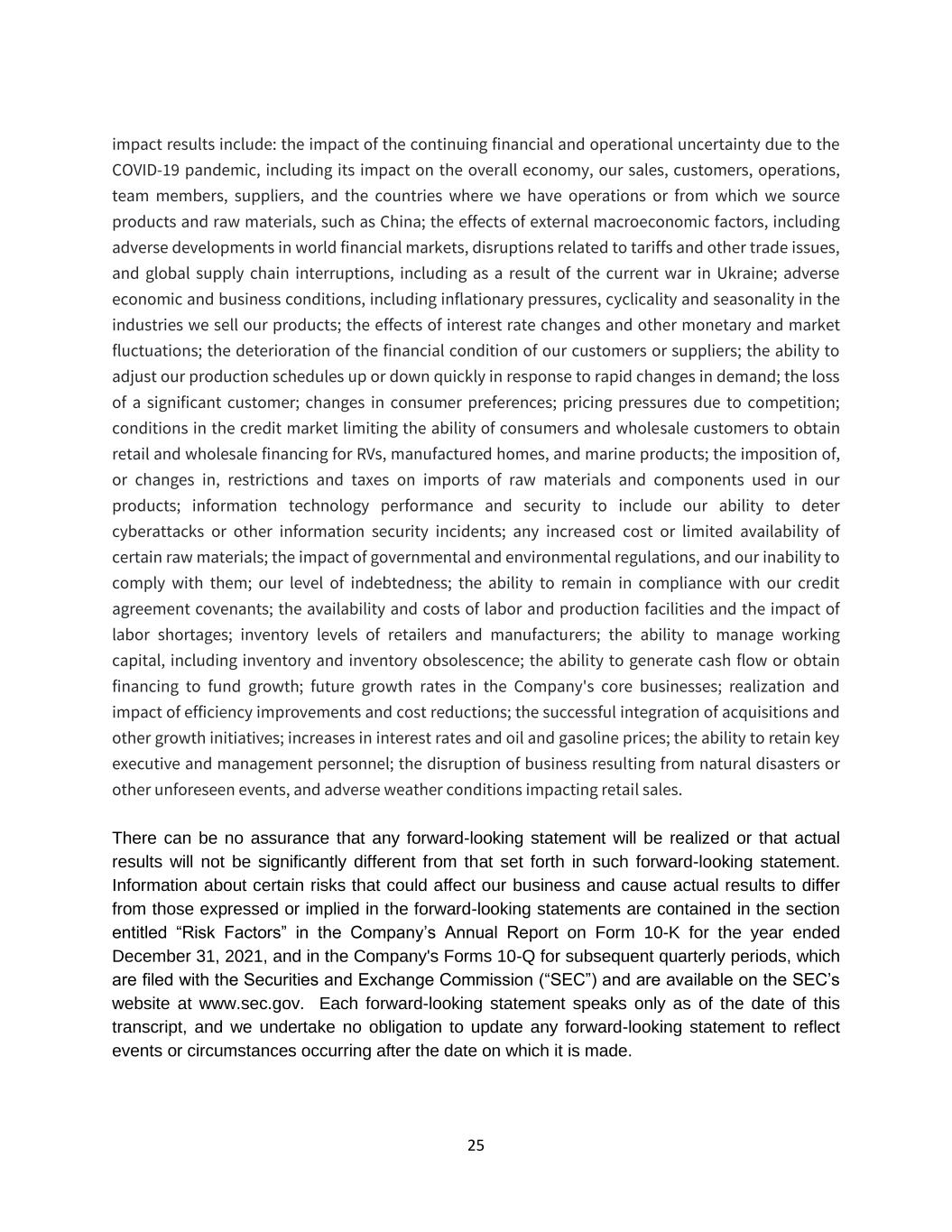
25 impact results include: the impact of the continuing financial and operational uncertainty due to the COVID-19 pandemic, including its impact on the overall economy, our sales, customers, operations, team members, suppliers, and the countries where we have operations or from which we source products and raw materials, such as China; the effects of external macroeconomic factors, including adverse developments in world financial markets, disruptions related to tariffs and other trade issues, and global supply chain interruptions, including as a result of the current war in Ukraine; adverse economic and business conditions, including inflationary pressures, cyclicality and seasonality in the industries we sell our products; the effects of interest rate changes and other monetary and market fluctuations; the deterioration of the financial condition of our customers or suppliers; the ability to adjust our production schedules up or down quickly in response to rapid changes in demand; the loss of a significant customer; changes in consumer preferences; pricing pressures due to competition; conditions in the credit market limiting the ability of consumers and wholesale customers to obtain retail and wholesale financing for RVs, manufactured homes, and marine products; the imposition of, or changes in, restrictions and taxes on imports of raw materials and components used in our products; information technology performance and security to include our ability to deter cyberattacks or other information security incidents; any increased cost or limited availability of certain raw materials; the impact of governmental and environmental regulations, and our inability to comply with them; our level of indebtedness; the ability to remain in compliance with our credit agreement covenants; the availability and costs of labor and production facilities and the impact of labor shortages; inventory levels of retailers and manufacturers; the ability to manage working capital, including inventory and inventory obsolescence; the ability to generate cash flow or obtain financing to fund growth; future growth rates in the Company's core businesses; realization and impact of efficiency improvements and cost reductions; the successful integration of acquisitions and other growth initiatives; increases in interest rates and oil and gasoline prices; the ability to retain key executive and management personnel; the disruption of business resulting from natural disasters or other unforeseen events, and adverse weather conditions impacting retail sales. There can be no assurance that any forward-looking statement will be realized or that actual results will not be significantly different from that set forth in such forward-looking statement. Information about certain risks that could affect our business and cause actual results to differ from those expressed or implied in the forward-looking statements are contained in the section entitled “Risk Factors” in the Company’s Annual Report on Form 10-K for the year ended December 31, 2021, and in the Company's Forms 10-Q for subsequent quarterly periods, which are filed with the Securities and Exchange Commission (“SEC”) and are available on the SEC’s website at www.sec.gov. Each forward-looking statement speaks only as of the date of this transcript, and we undertake no obligation to update any forward-looking statement to reflect events or circumstances occurring after the date on which it is made.

26 This is a transcript of this conference call that we have attempted to accurately transcribe. There may be errors, omissions or inaccuracies in this transcript. We do not assume responsibility for your use of this content, and we encourage you to do your own research, including listening to the call yourself and reading the Company’s SEC filings.